Wednesday, 31 October 2018
New Superstar Glitters
Check out these amazing new glitters from Superstar, these are now availble on our website and in store.
Shopping link - https://www.thefacepaintingshop.com/face-painting-Accessories-the-face-painting-shop/Glitter/Superstar-Glitter
Tuesday, 30 October 2018
Face Painting Hygiene
Lets talk about Hygiene by Kathryn Craig
Hi everyone! By the time you read this you are probably in the midst of the Halloween madness, knee deep in latex and fake blood! I hope it’s a lucrative period for you all, and look forward to seeing the amazing faces that you have all created!
This week I am going to talk hygiene. Everyone has their own ideas about what best practice means for them, and as there is no actual official rule on what we should and should not be doing when it comes to working, it is ultimately up to each individual painter what way they choose to do things. I will freely admit that it’s a bug bear of mine, and as such, my practices may seem extreme to others, but for me, it is about taking all reasonable steps to minimise the risk of cross contamination, and reduce the chances of being the reason that someone becomes unwell or suffers a reaction from work that I have carried out. People are covered in germs and bacteria, none more so than children, so it’s not possible to completely eliminate this from face painting, and that’s not the aim here. The aim is to reduce any risk as much as is practically possible, while still being able to work fast, and efficiently, and doing what you feel is right for your business.
Let’s start with your kit in general. I deep clean my kit after every day’s work. For me, this involves wiping over every paint surface, container, cup, stencils and poofer etc, giving my brushes a good clean and machine washing my sponges. I use a fresh towel and tablecloth for each job. It really doesn’t take that long... maybe 30 minutes on average, and for me, it’s crucial that I arrive at every job with a clean kit. I have had many parents / clients comment that they are pleased to see that my kit is clean, and this is one of the things that sticks in client’s minds and makes them remember you when it comes to booking entertainment for their next event. We have all seen photos of horror-kits online, or in real life, and it genuinely baffles me that any parent would allow their child to be painted by products that look so unsanitary. It’s also about taking pride in your work, your working environment and your tools. I love my kit. I invest heavily in it, and I want to look after it – my livelihood depends on it after all!
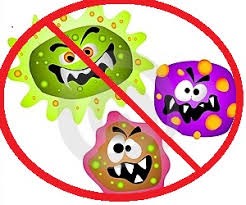
Paint
Did you know that all of the paint products that we use have a limited shelf life once opened? For most paints, this is 12 months. After this time, they should not be used. You can find this information on the label as shown below. While our paints do contain antibacterial agents, these are designed to delay any mould growth in damp paint, and do not kill viruses / prevent cross contamination. After 12 months, these agents will not be providing the protection from mould growth that they previously would have, and therefore the paint is likely to be less sanitary than before. I’ve talked about repotting before, and mentioned that I keep a note of all batch numbers and expiry dates. If you repot your paints, it’s a really good idea to do this, so that you can keep track of what expires and when.
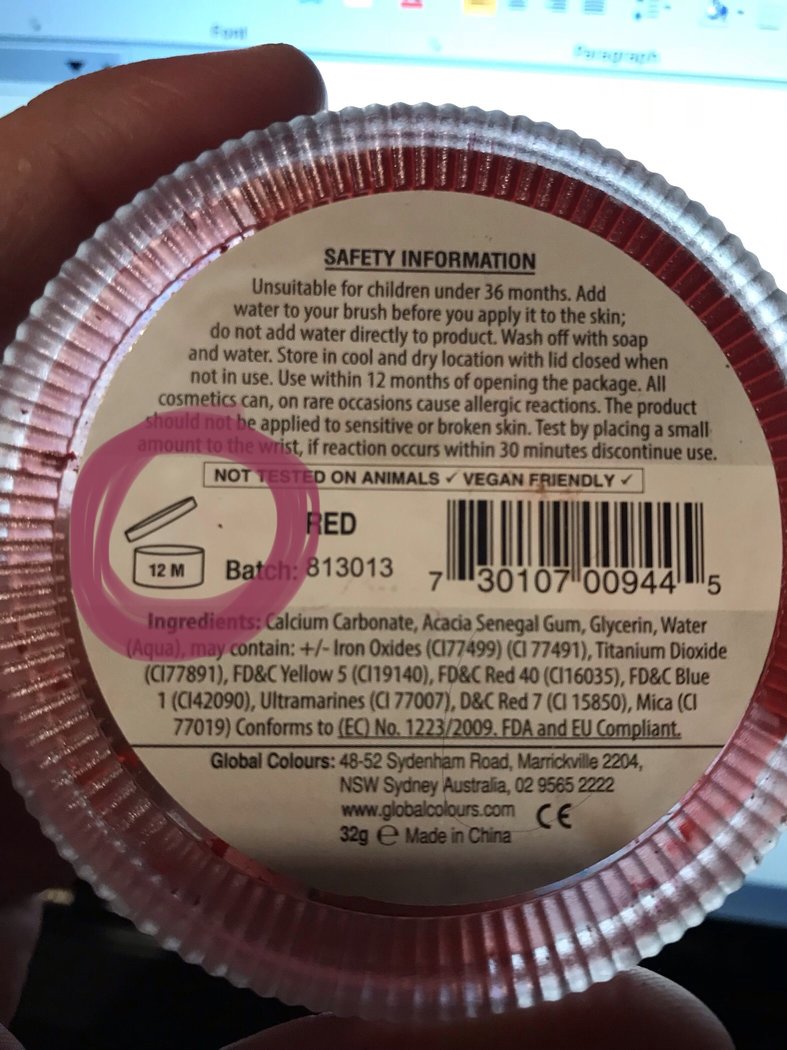
Brushes
Jane posted a fab blog post recently about how to clean your brushes between gigs, so I’m not going to talk much about that, and will instead focus on on the job hygiene practices. Face painting water gets mucky. There is really nothing that we can do to eliminate that due to the amazing array of pigments in our paints, but there are easy steps that can be taken to ensure that your brushes stay as clean as possible during a job. Rule one… never leave your brushes standing in water. It damages the bristles, the ferrule, and it leads to cracking flaky paint on the handles... never a good look, and a perfect breeding ground for nasties. Personally, I operate a 3 cup system, and while it took a little getting used to at first, it works well for me now, and doesn’t slow me down at all. The first cup contains water, and is used as a first rinse. The aim here is to get as much paint as possible out of the brush. The second cup contains water, and a brush sanitiser. I use Brush Bath by Silly Farm, which is 100% organic and smells divine. You only need to add a few drops to the water, so it lasts for ages and it will not damage your brushes. My third cup contains only water, and is only used to rinse after the second cup, or to load a fresh brush. I can work a long and busy job, and the water in this cup stays clean throughout as it is never used for a painty brush.
Sponges
So...the great sponge debate! There are two very different schools of thought on this. Lots of painters use a ‘one sponge per colour’ system, where the same sponge is used to apply paint to lots of faces, before being washed. Alternatively, others use a ‘one sponge per face’ system meaning that sponges are not used on more than one face before being washed. Personally, the idea of sponge sharing doesn’t sit well with me. While I am sure that no one is painting over open gaping wounds, or visible infections, it is important to remember that the majority of infections are contagious before they are symptomatic, so there is usually no way of spotting that someone is brewing up something you don’t want to share! Also, just because it hasn’t happened, doesn’t mean that it never will, and if you are ever in a situation where a client has raised concerns about infection or reactions, you need to be able to prove that you work as safely as you possibly can. I want to minimise any risk of cross contamination and therefore I can’t get past the knowledge that I could be passing cold sores, conjunctivitis, impetigo, chicken pox or God knows what else, along a line of little people. Also, I don’t want those things in my paint, or on my hands if I can avoid it! I have loads of sponges, (I tend to cut regular face painting sponges in half which instantly doubles my stock!) and I have 2 mesh bags – one for clean, one for dirty. My sponges come out of one, are used, and go into the other, where they stay until I wash them after the job along with my towels and tablecloth. I add a laundry disinfectant to the load to ensure that they are squeaky clean before being reused. Interestingly, I have noticed that reusing sponges seems to be more common in the US than the UK, and can only assume that this is because there are a number of high profile American painters who do so. Again… this is a decision that only you can make, but it is important that you research both techniques before deciding what you are happy with. I have had parents comment that they are pleased to see that I do not reuse sponges, and that alone is a good enough reason for me to have a single use policy. Clients notice more than just the end result of our work! Any professional face and body painting organisation that I could find all have a ‘clean sponge per face’ criterion in their working guidelines, including FACE – The International Face Painting Association. There are also some regions within the UK where individual councils have constructed a policy on safe face painting practices and again, any that I could find online all stated that sponges should not be used on multiple faces. Some countries like Canada have super strict rules on face painting that mean that even brushes cannot be reused without being ‘properly’ cleaned.
Hands
It’s not just the kids who are walking buckets of bacteria… we are too! Our own personal hygiene is important also, and where possible, I always wash my hands before setting up my kit. I carry antibacterial hand gel to use between faces, and (now that I’ve mostly ditched my baby wipes thanks to Nat’s campaign) I have a clean cloth for my hands. I can be a kind of messy painter, especially on long and busy jobs and I think it looks bad to be painting and handling face, brushes and sponges with painty hands, so a quick wipe between faces really helps.
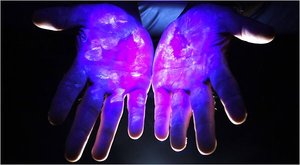
Workspace
People see messy and think dirty. While your table itself is unlikely to get dirty during a job, it may (if you are anything like me) become untidy during a busy gig. Don’t be afraid to take a few minutes to do a quick tidy. I usually allow the next person into the chair and tell them that I am just going to have a quick tidy up. I’ve never had anyone complain about that, and it’s good that your clients see that you are making sure that everything is clean for them.
So there you have it. It’s pretty simple! Start with a clean kit, take steps to keep it clean and safe on the job, and clean properly when you are done, and you shouldn’t go too wrong. If you wouldn’t accept it from a MUA working on your face, then it’s not ok to expect your clients to accept it from you! If you are interested in reading some more opinions and experience about hygiene, I posted a poll in the Face Painting Shop Tips & Tricks group on Facebook which has had over 200 inputs from other painters on how they manage cross contamination risks. It always good to see what other painters are doing and why, so feel free to have a read and add your own comments!
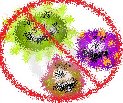
Kathryn
Monday, 29 October 2018
Face Painting Kit Essentails
Kit Essentials-cake paints
This week I thought I would continue my ‘kit essentials’ series and talk about my essential cake paints to take on a face paint job.This is pretty much all the cake paints I’ll take on a general paint job, but if I have a themed event I adjust my kit accordingly. I don’t like to take much more paint than this out with me as I use a lot of rainbow and split cakes, and it also helps keep set up and break down times to a minimum.
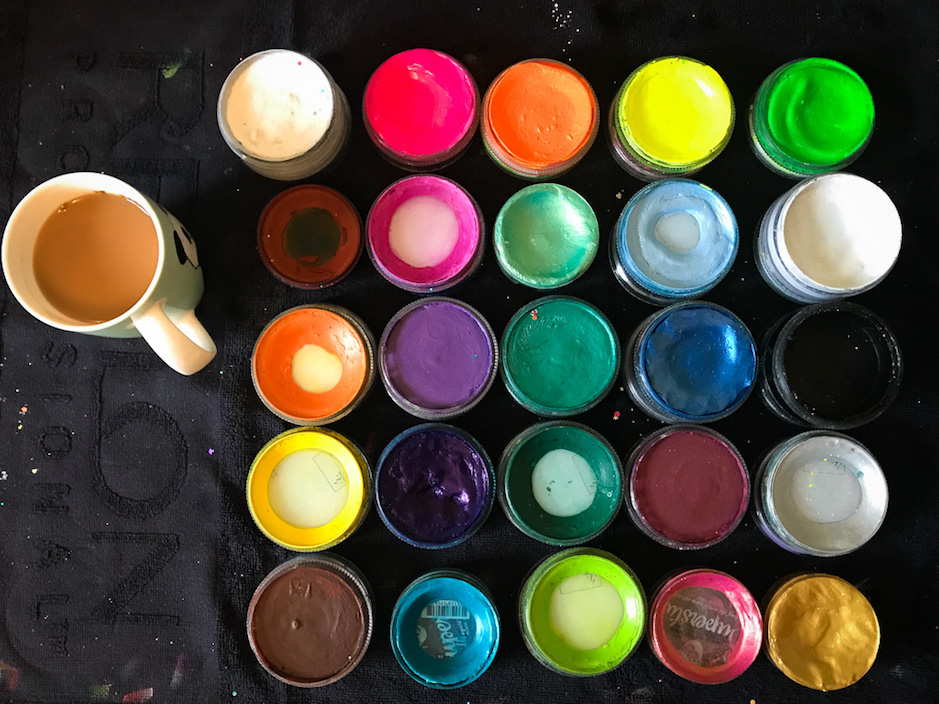
So this is my set up of my cake paints. They always come out in that order, and then they go back in the bag in this order! I keep the black and white next to the water and arrange them in colour order going away from the water with UV’s on top.
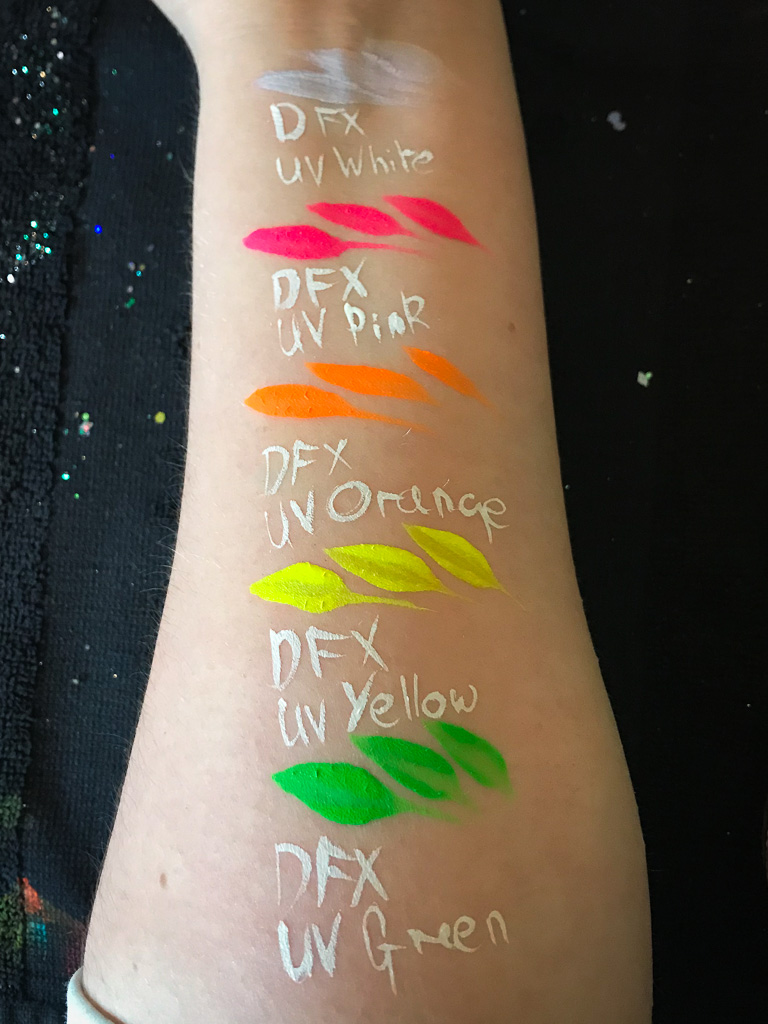
DFX White: Ok, so I’ve tried a fair few whites, and for me, this one comes out on top. I use it for both linework and spongeing on the job. HOWEVER for private appointments,I prefer to use white or very pale foundation (The Stargazer one is fine). It feels much nicer on the skin and takes paint well on top, and won’t sweat off as easily as a painted base.
DFX Black: This is my go to black for on the job. It’s great for line work, and blends out really nicely, and, like the white, I have tried several other blacks, and have come back to this one. However I am yet to come across a matter black than Mehron Paradise Black, which I use a lot for body painting, and for things like skulls and zombies on private bookings where you want more than just linework.
DFX Metallic Silver: Ok, if I’m honest, I don’t use this a lot, but it is useful to have a silver in your kit. I use it for the odd bit of outlining, or if someone wants a robot or something, but mostly, it’s there incase I need to mix it with a flat colour to make it shimmery.
Superstar Glitter Gold: This is such a beautiful colour. I love the softness of Superstar paints, and I love the pigmentation! I have tried a couple of other golds, but since I came across the Superstar Glitter Gold, I haven’t gone back to any other gold paint for face painting.
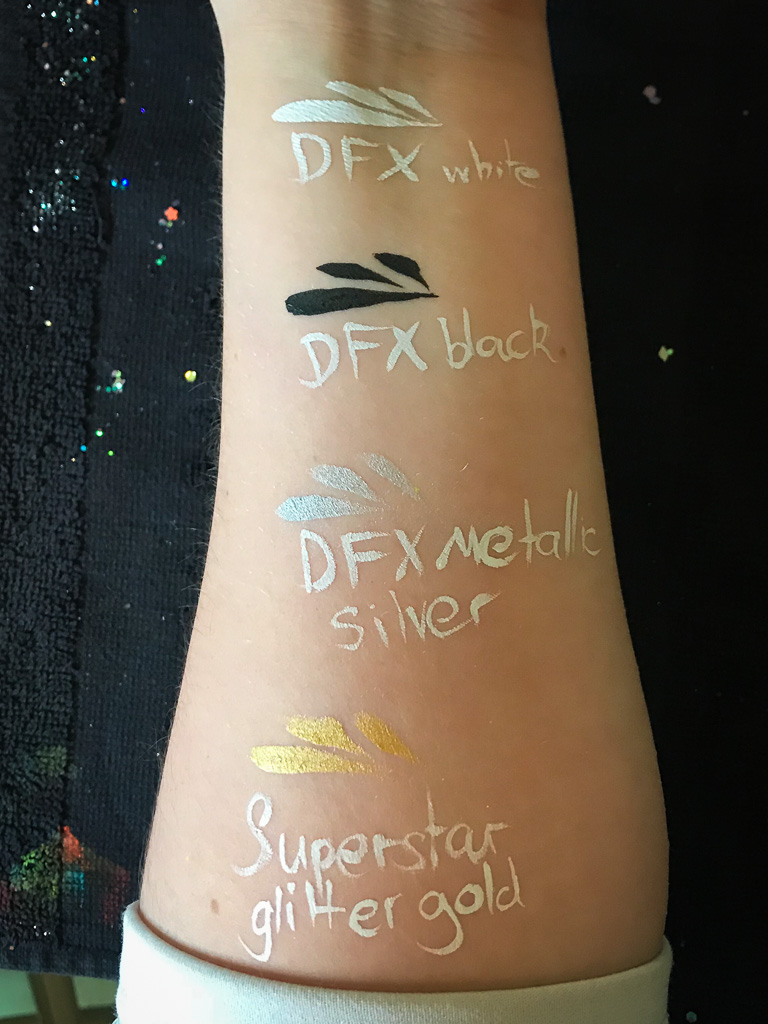
Global Pearl Baby Blue: This is such a great colour! It makes such a great blue tiger (combined with Cameleon Victorious) as well as the base for my galaxy design, and is great for outlining things like butterflies.
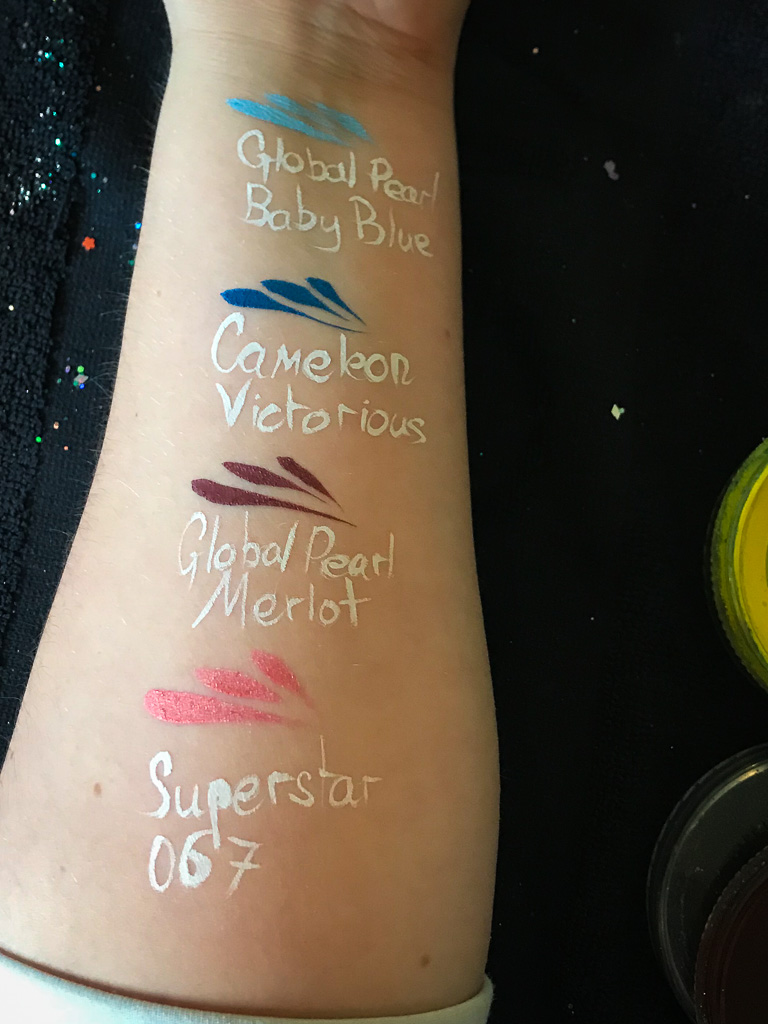
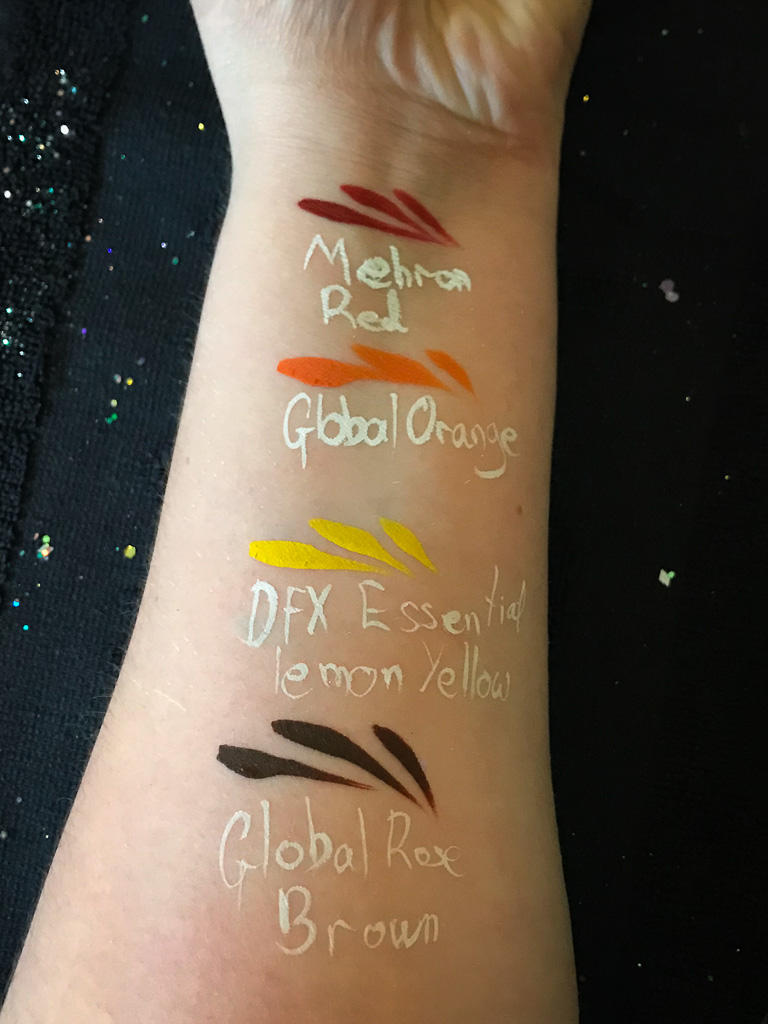
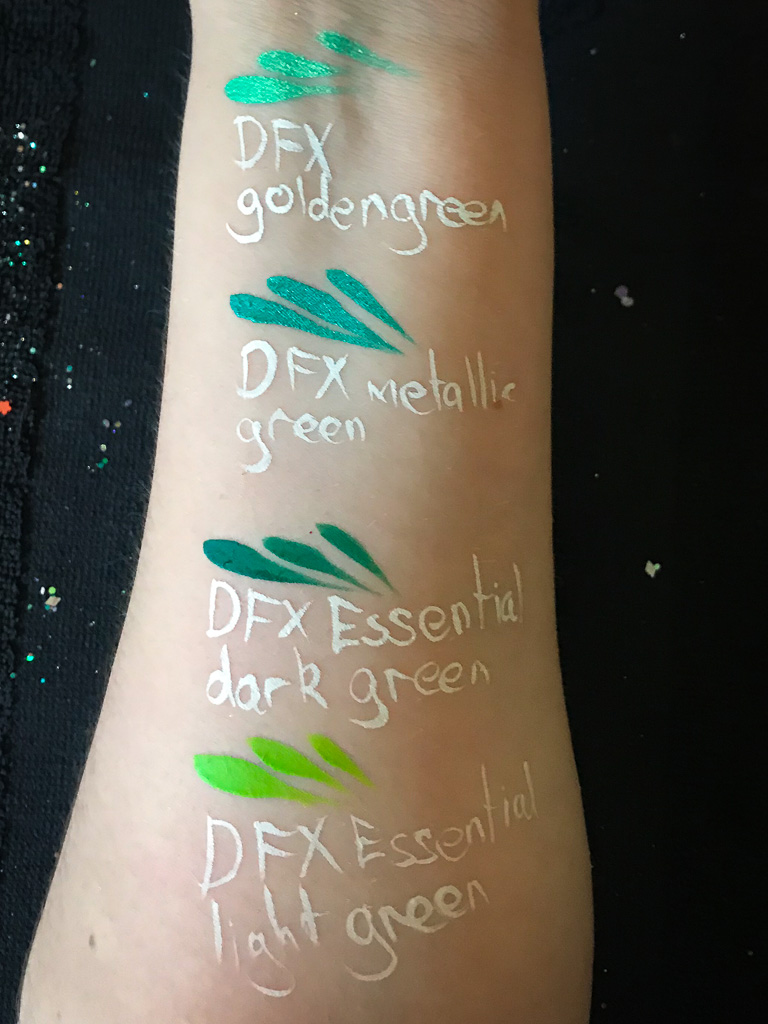
Mazz x
Wednesday, 24 October 2018
New Ben Nye kit
New Ben Nye kit has just lannded on our website #new #BenNye # Halloweensupplies #SpecialEffects
Shopping Link - https://goo.gl/WDscpB
Tuesday, 23 October 2018
Diversifying Your Business: running workshops
Diversifying Your Business: running workshops
This week’s blog will talk you through how to earn money through diversifying your business; in particular, teaching children’s face painting workshops.
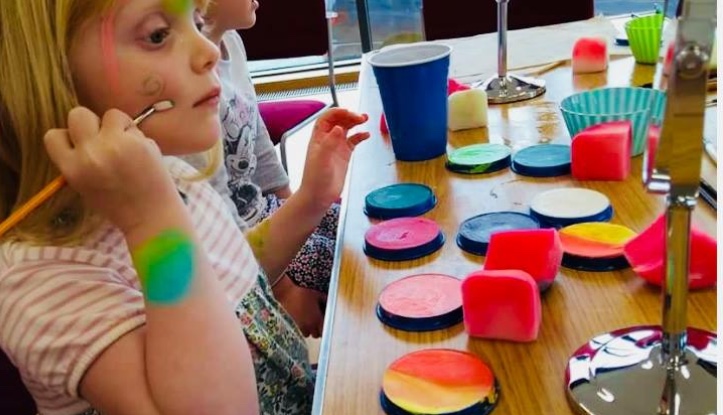
Kids love to be painted but they love painting themselves even more. From the 4 year old who instantly becomes Hulk with a muddy-green, watery face to the quiet pre-teen, carefully creating her festival design, face painting is magical to children, especially for those who aren’t encouraged or able to get painty or glittery at home.
If you choose to run a learn to face paint workshop I guarantee places will fill. Here is my guide to making your sessions a success, based on my own experience and my training as a Primary teacher. Choose the best time for your workshop. After school and weekends are too busy for most families and the Christmas holidays are already an expensive time of year. Half terms and Summer holidays are perfect.Keep the sessions short, children finish activities at different speeds and you don’t want kids sitting bored for half an hour. Have extra activities for early finishers.Make a list of rules and email them to the parent or carer so they all know the expectations regarding health and safety, allergies, behaviour etc.
Make sure you have enough resources – kids like to gouge their way through your paints. I use snazaroo rounds cut in half and joined together with another colour to make cheap, effective rainbow cakes. Don’t throw away any of your old face painting brushes, give them a new lease of life – make sure kids have access to a flat and a round and maybe a petal brush too. Sponges, water pots, towels for spillages and that’s your lot. If you want to ramp it up a bit grab some glitter guns, stencils and bio chunky glitter.
If you’re teaching older children, teens and adults, the Training Tried and Tested boards by Sally-Ann Lynch are perfect. Younger children like to take their work home with them so cut up large squares of baking parchment and draw felt tip faces on.
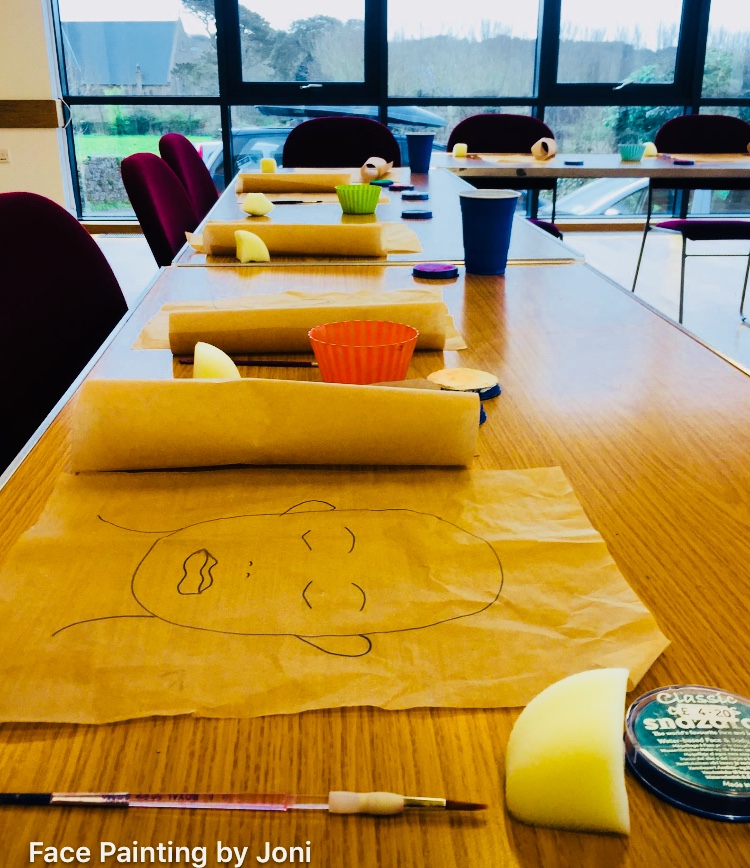
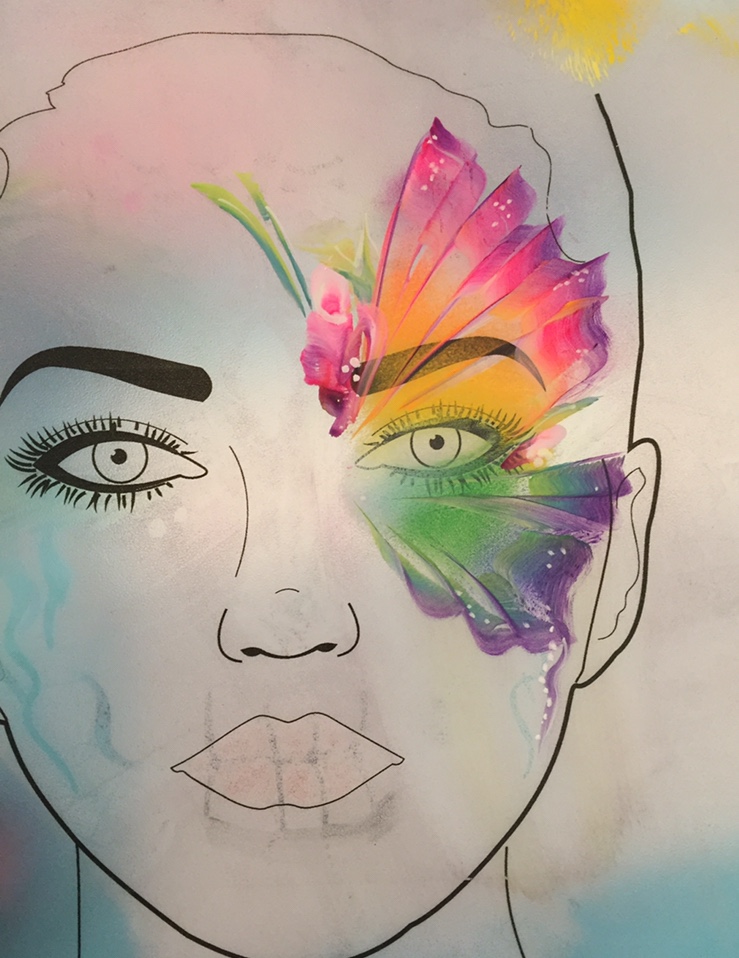
Keep your teaching pacey and simple but have stretching tasks for the more able.
Invest in sturdy stand up bathroom mirrors so they can paint their own faces if they want to.
Consider making up some mini kits that the children can take home.
You can make up little samples of the products used in the workshop so they can practise their new skills. For Halloween my mini kits contain samples of wax, blood, zombie skin and siliglass. Charge for these, they’re not freebies! Wrapping a bow around the box them makes them attractive too. If you use business cards, pop one in each kit.
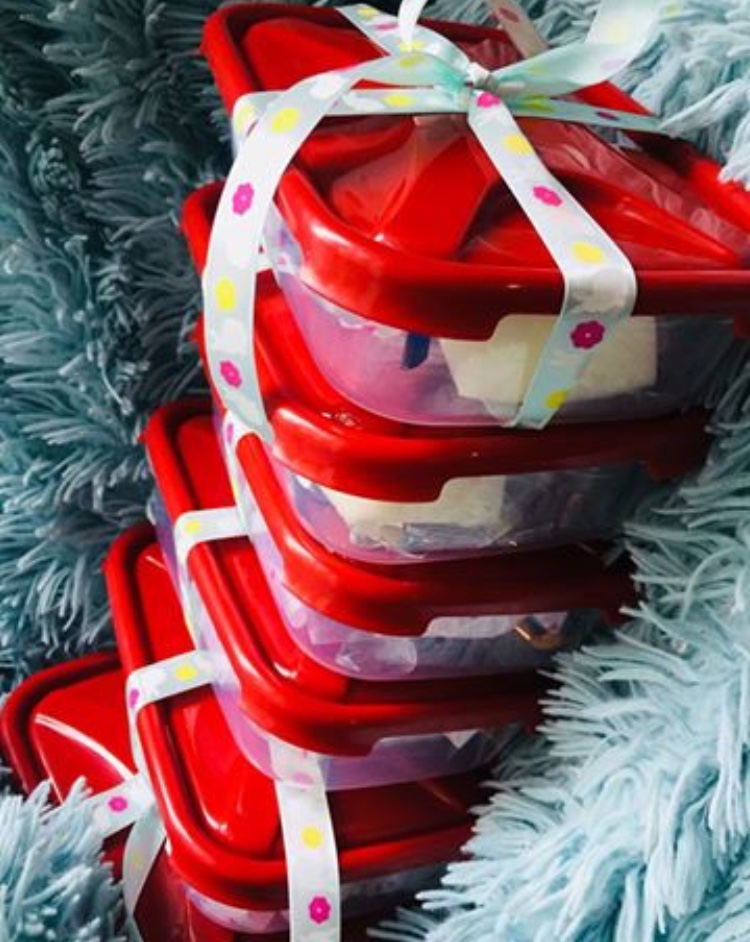
If the workshops are profitable why not offer ‘family’ facepaint workshops, gore and sfx or teen only sessions? Above all else have fun, enjoy helping others and don’t forget to take lots of photos to use for Marketing, you’ll want to do it all again next holiday…
Is this something you already do? Leave a comment and share your top tips and experiences, I’d love to hear from you.
JONI NETTLESHIP
FACE PAINTING BY JONI
Monday, 22 October 2018
Face Painting Kit Essentails
When I first started thinking about writing a post about my kit
essentials, I was going to do the whole lot in one. I then realised that
actually there’s too much to say to cover all my kit essentials in one
post, so I’ve decided to break it down into various categories, and this
week, I’m going to talk about brushes.
Good brushes can make a huge different to your work, and the way that different people get on differently with different brands of paint, is also true for brushes. I think if I was going to break it down to my absolute bare minimum on the job for face painting, I could get away with using just 4 brushes: Party Xplosion Round 5, Pink Tip 3/4 inch short angled brush, Pink Tip Flora 12 and a Toothbrush. I do have some other brushes that I absolutely love, so I’m going to talk about those aswell, but the ones listed above are the ones I’m going to focus on.
Party Xplosion Round 5
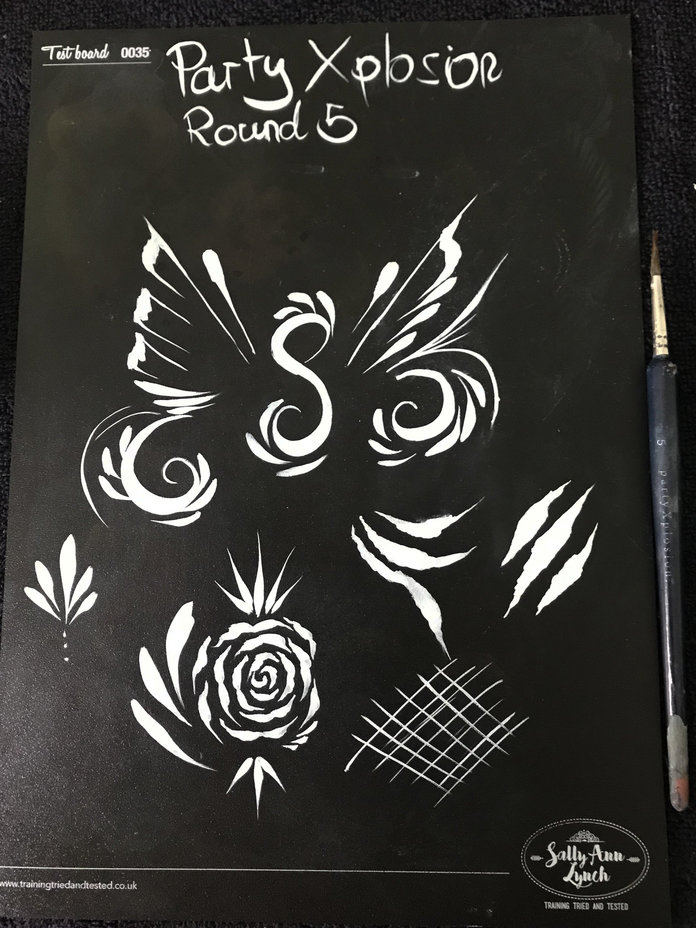
This is my favourite brush. Ever. In the world. The bristles are really flexible which makes it really versatile. It’s brilliant for things like outlining, tear drops, tiger stripes, scars and scratches, and really fine lines. I actually have 3 of these in my kit so I can have them on different colours at the same time. I did try the Party Xplosion round 3, but I didn’t really get on with it because the bristles weren’t as flexible, and I haven’t tried any of the other sizes to compare, but this brush is life.
Pink Tip 3/4 Short Angled Brush
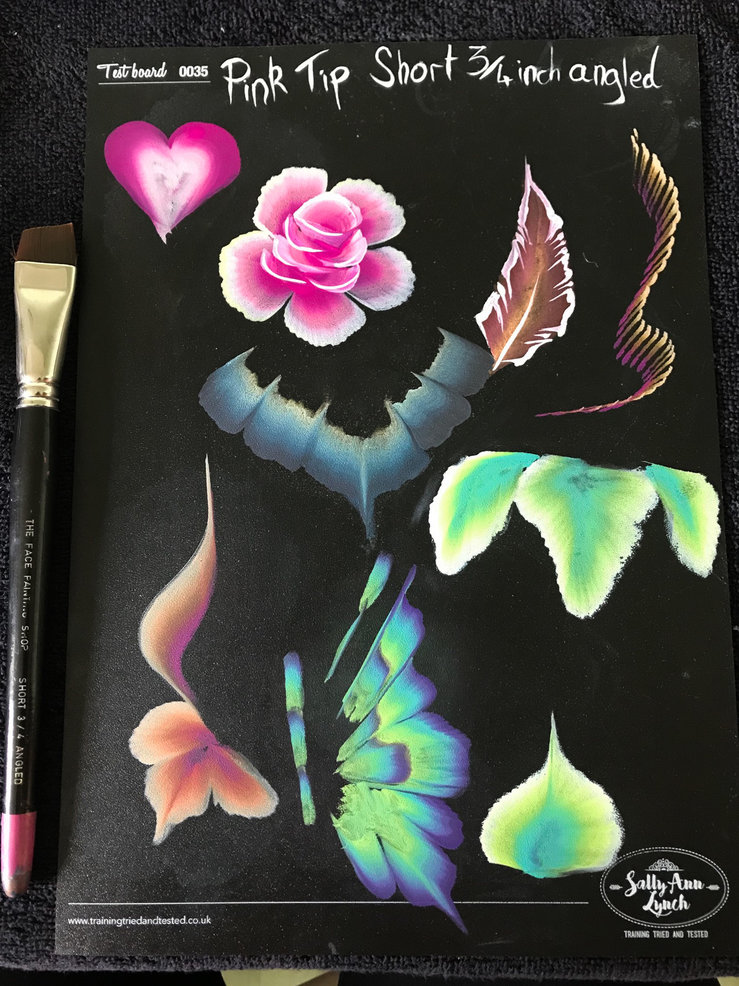
I really struggled with one stroke until I tried this brush. I had been using a flat brush but this one gave me so much more control, it’s great for so many things! I mainly use it for roses, butterfly’s, feathers, eye designs and sugar skulls, but I know a lot of people use theirs for so many different things!
Pink Tip Flora 12
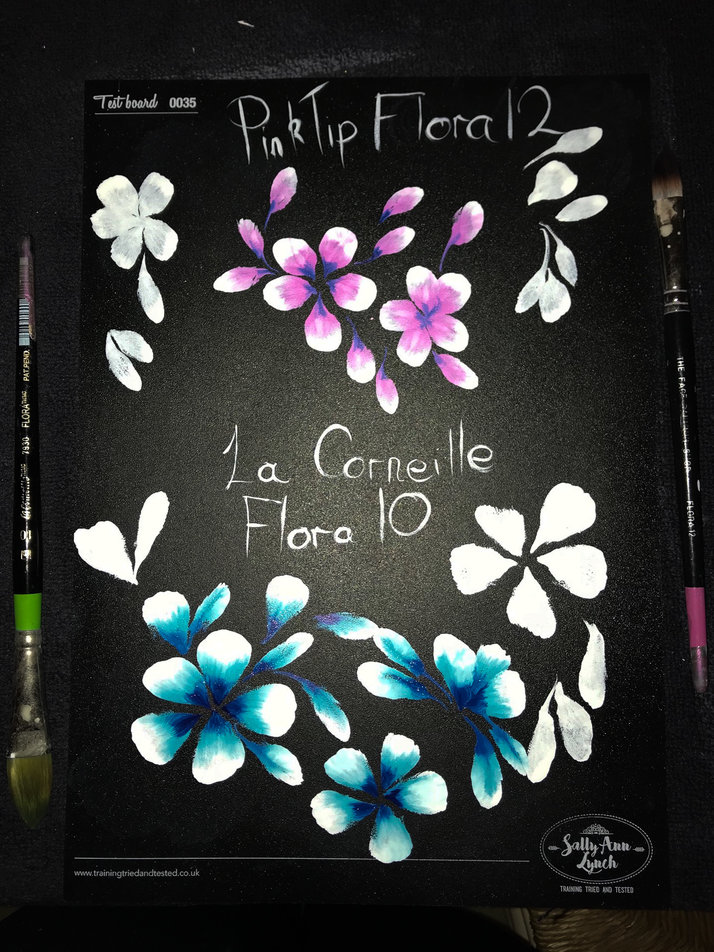
I discovered flora brushes at a workshop with Erica Wafford at Body Craft Festival 2017! I had been really struggling with flowers, and straight after the workshop I went to buy the La Corneille Flora 10, and completely changed my body paint design for that day to incorporate the flowers. A few months later, The Face Painting Shop did a video about their new large flora brushes, and I immediately bought the Flora 12, and I absolutely loved it! It gives more of a rounded petal shape to the La Corneille, and it’s slightly smaller so I find it’s better for face painting. They work really nicely together, but on the job I tend to go for the Pink Tip every time.
Toothbrush

Ok, so it’s not very versatile in terms of different strokes, but I absolutely love using a toothbrush! One of my favourite designs to paint is a galaxy, and to create all the stars, I use the toothbrush with a variety of colours over a dark base (I find uv colours work best for this). It works great for creating eye masks, and blood splatters, and is a great tool for your sfx kit too when using alcahol paints.
Dagger Brushes
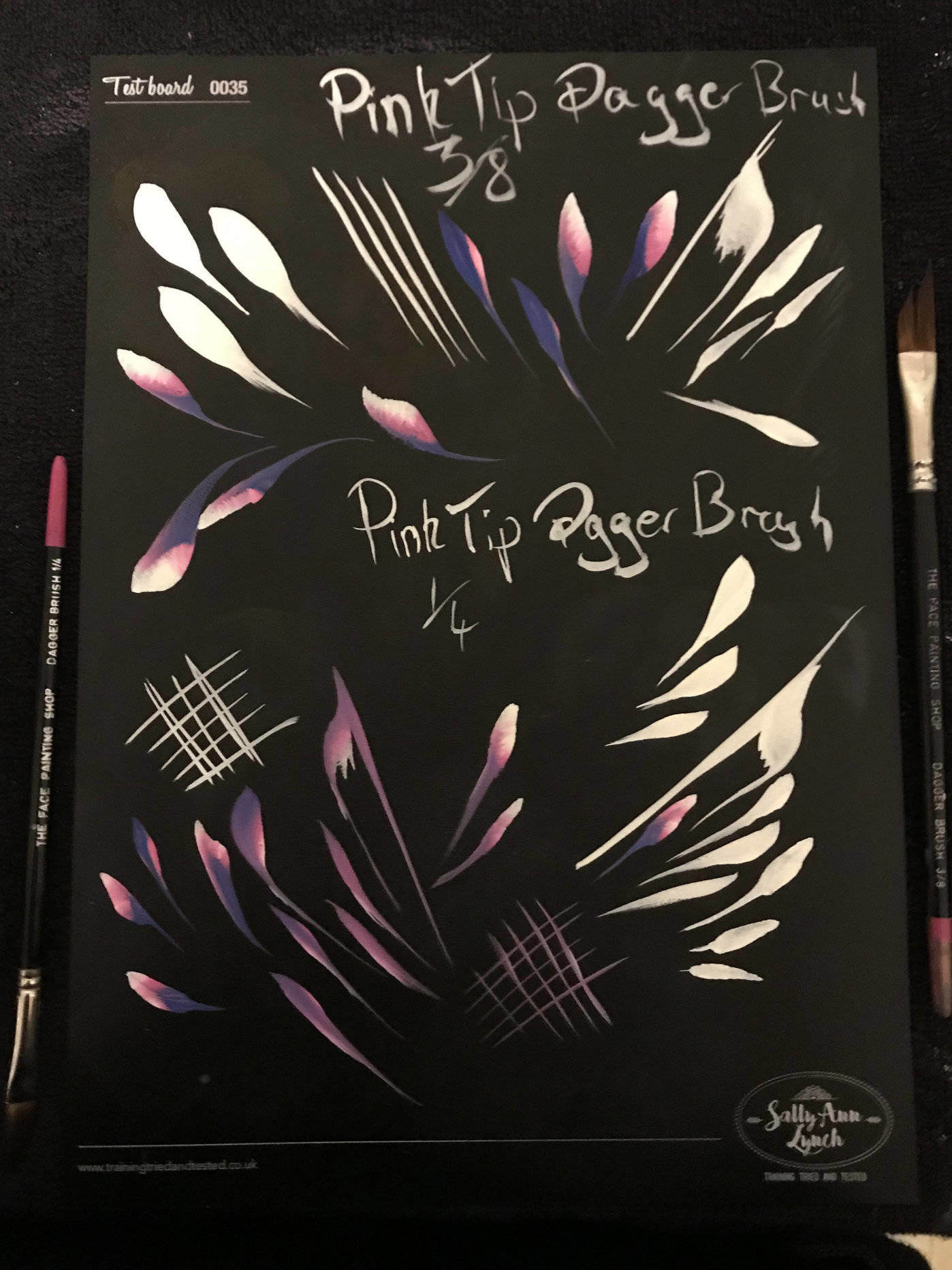
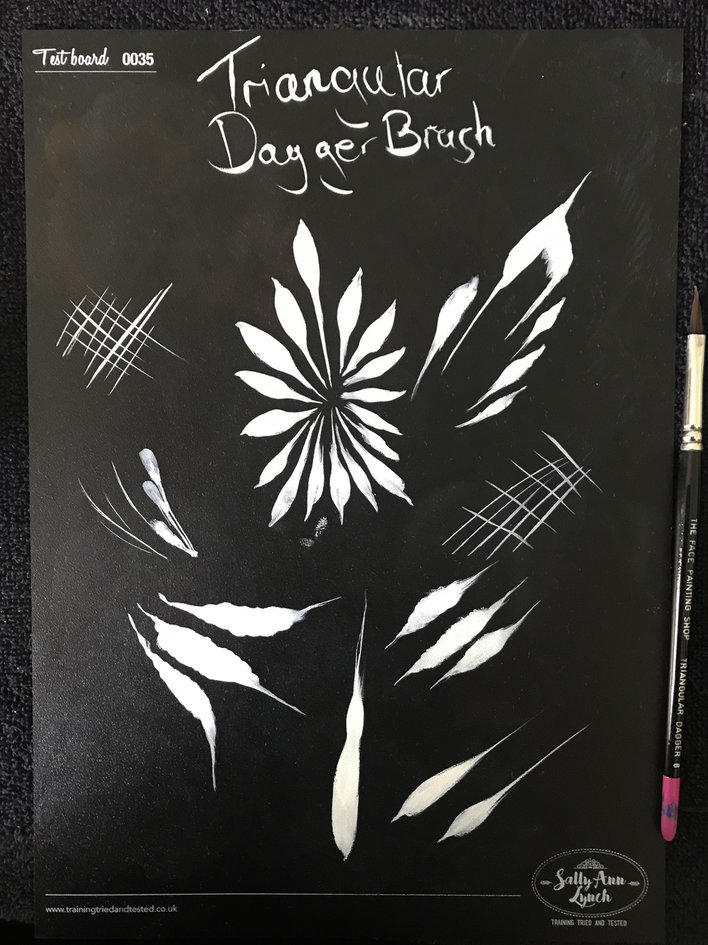
When I started using dagger brushes, it was to improve my one stroke roses, I never even contemplated using it for anything else! I no longer use it for roses but do use it to create petals and tear drops, and now we’ve been blessed with the new Triangular Dagger Brush!
Big Brushes
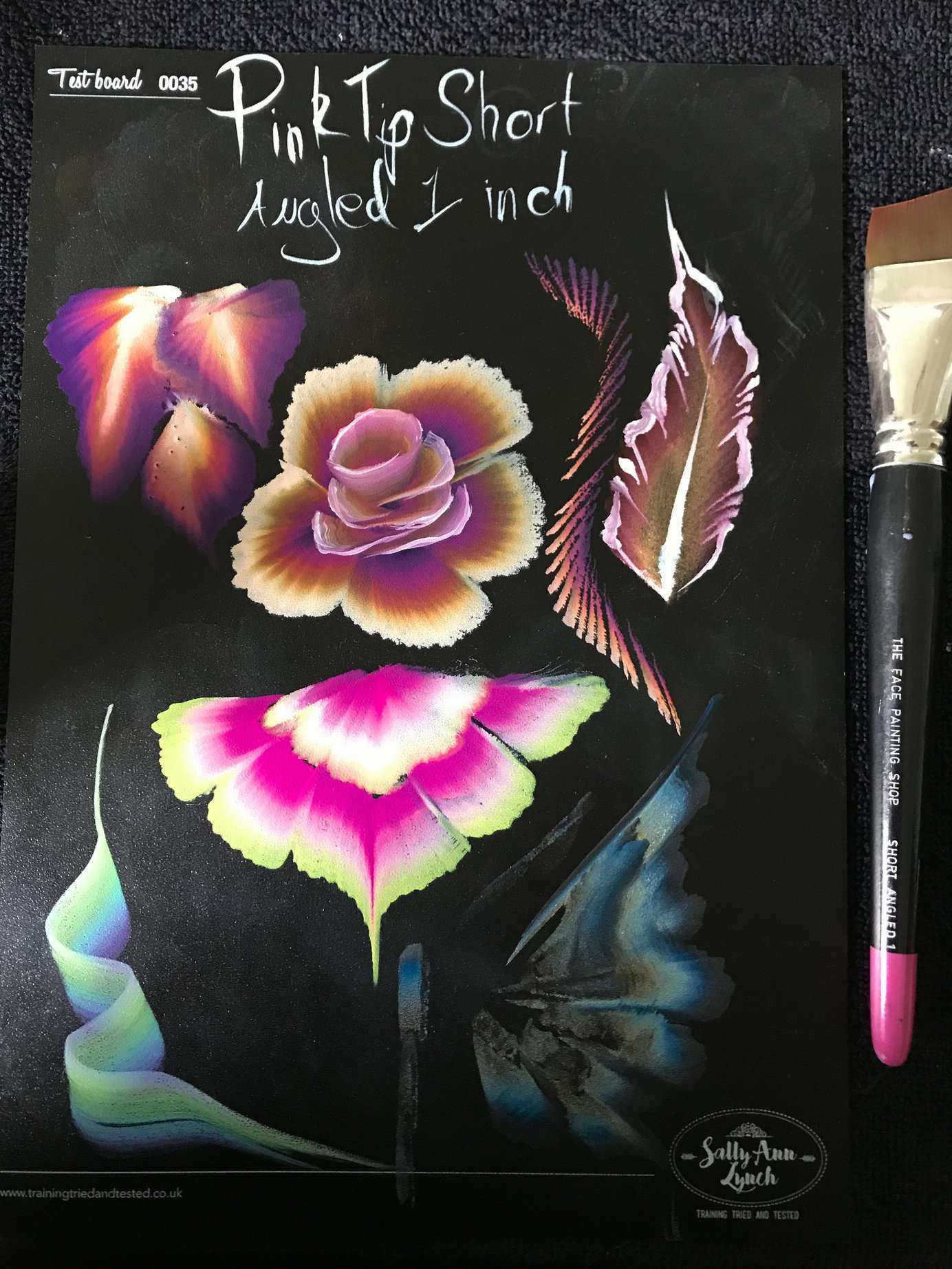
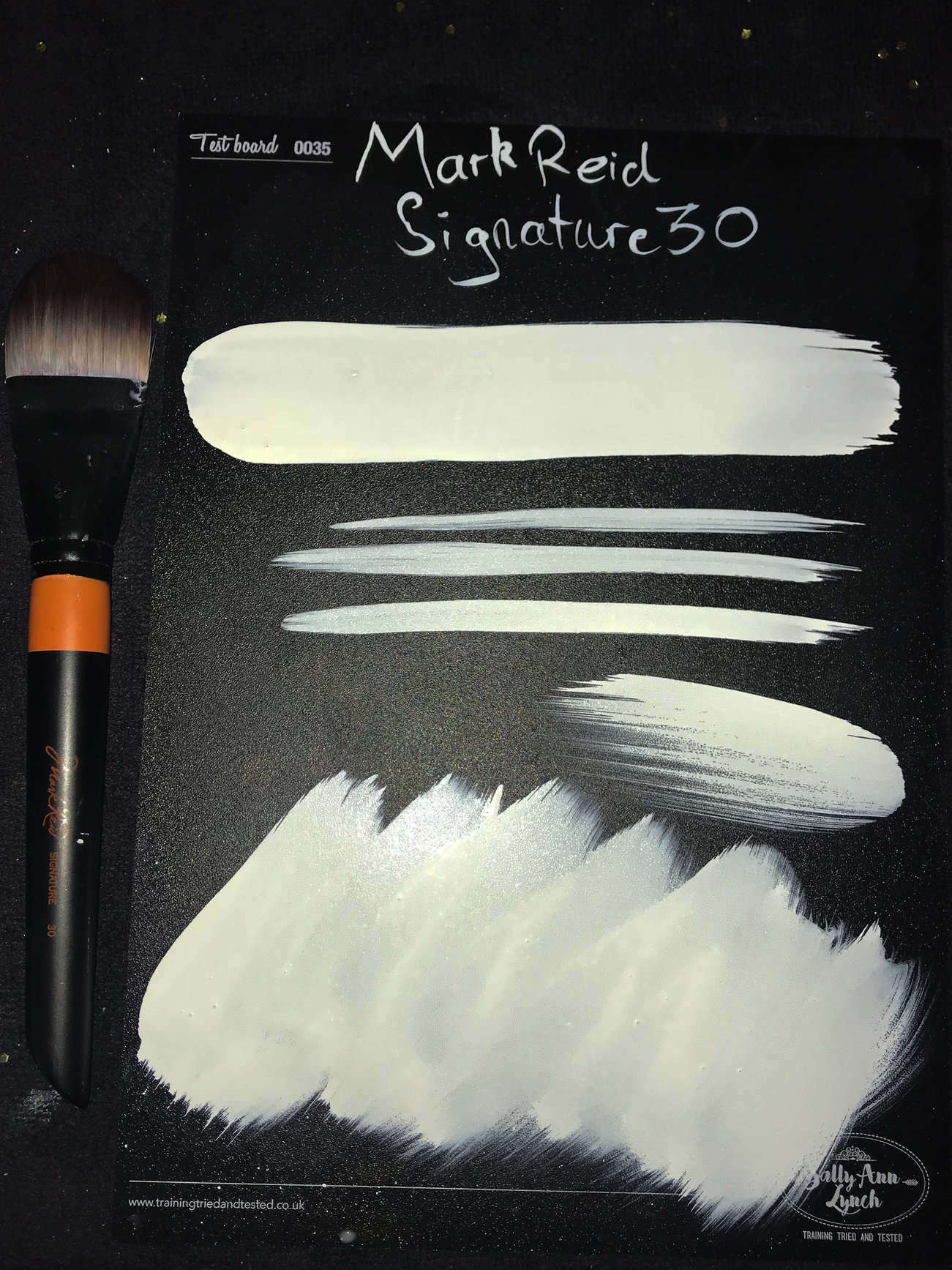
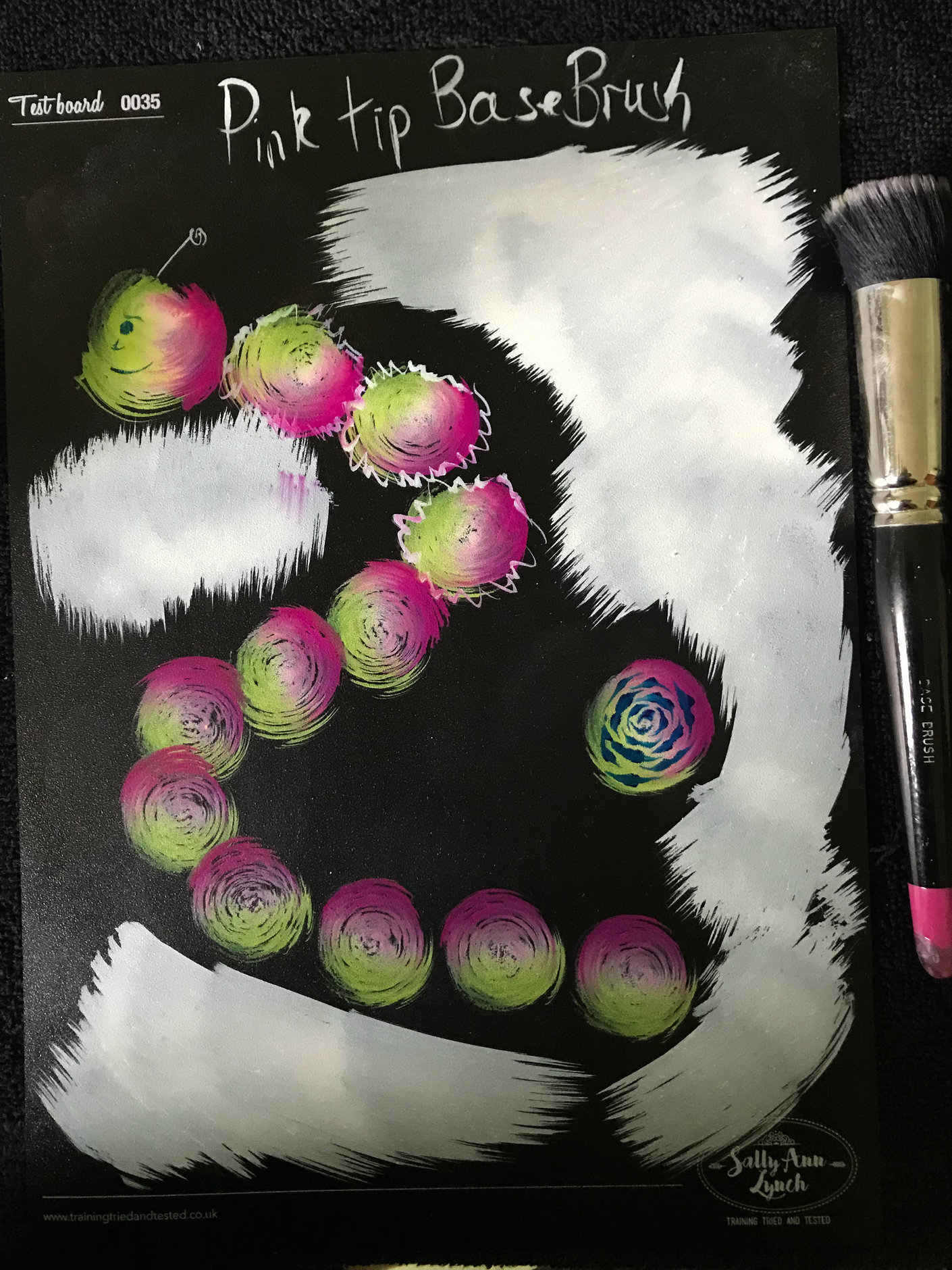
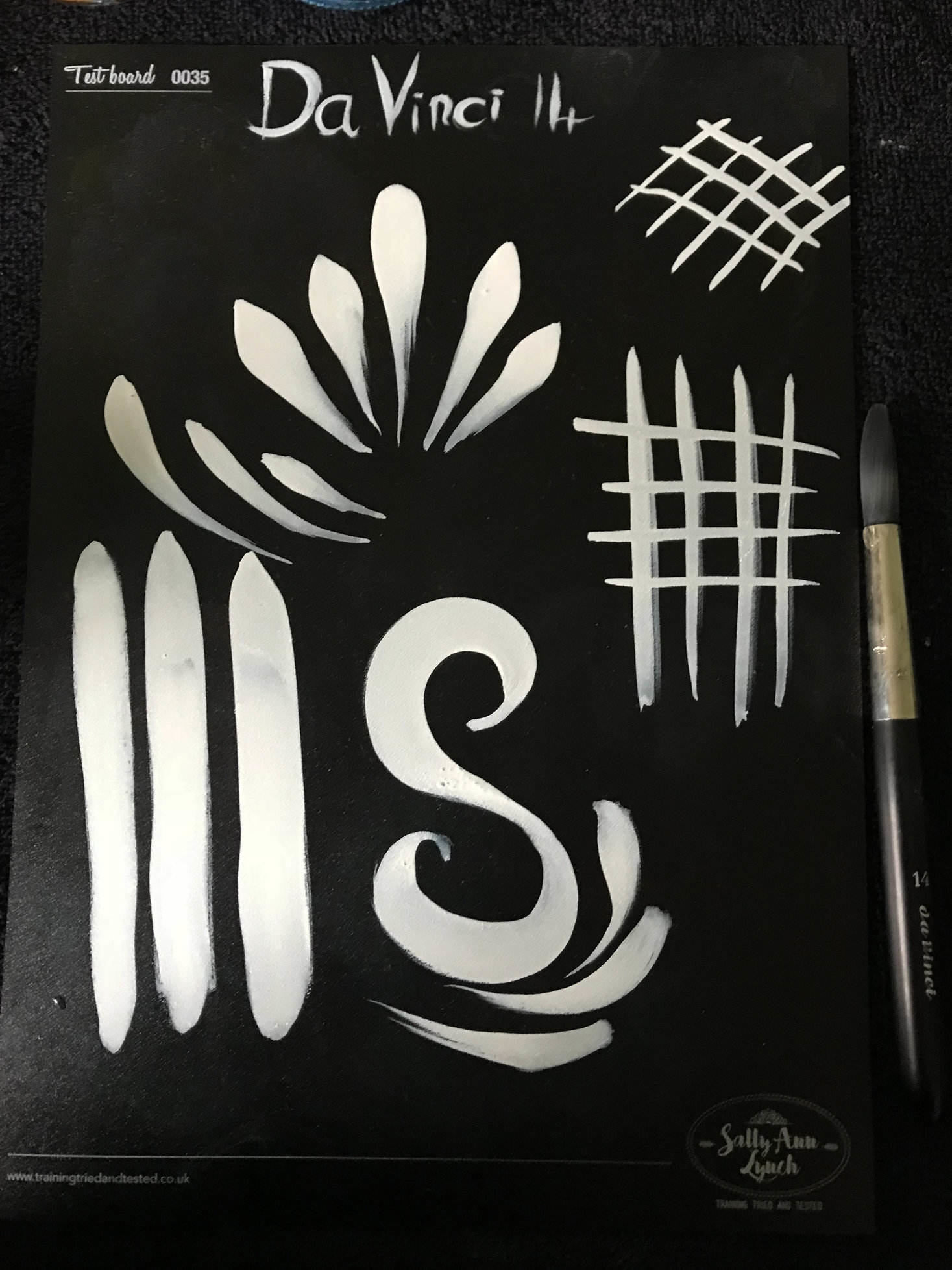
I love myself some big brushes! Until this summer I was using foundation brushes for body painting when I decided to bite the bullet and buy the Mark Reid signature 30, and I have to say I absolutely love it! I also have the Pink tip base brush, but I prefer that for use on the face and use with one strokes to create flowers and caterpillars. I also love my 1 inch short angled brush! It’s great on adult faces, but I find it’s just too big for childrens faces, which is where the 3/4 inch short angled brush comes in. I also bought myself the Da Vinci 14 brush this summer, which is brilliant for body painting linework, and like the Party Xplosion brush, the bristles are really flexible and you can get a pretty good variety of thickness of strokes from it.
Small Brushes
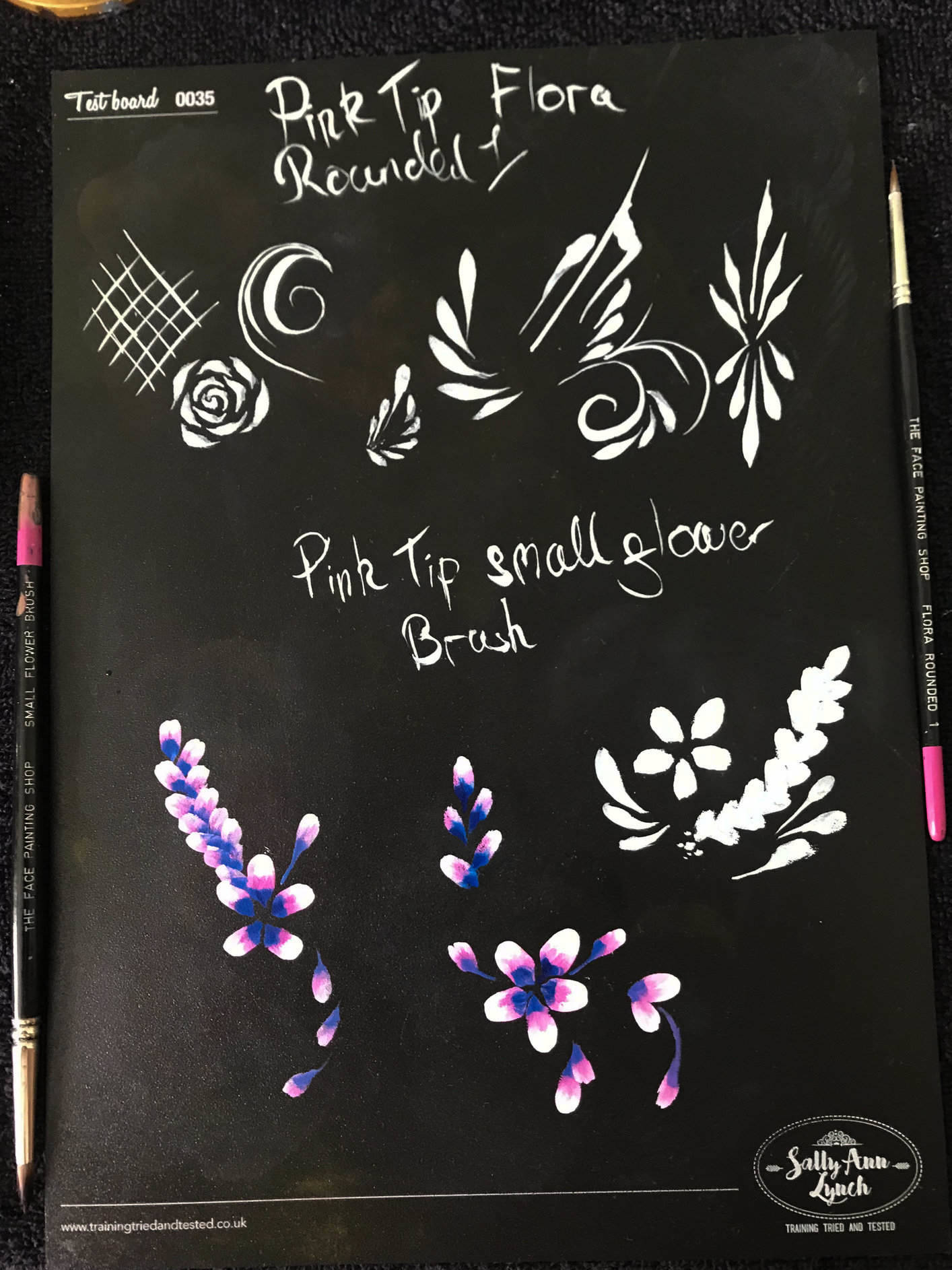
The last 2 brushes I want to talk about today are both pretty new to my kit, but I love them! The Pink Tip Flora Rounded 1 has a great fine tip, so you can get really precise linework out of it (it’s also what I’ve used for all of the writing on the boards in the photo’s) as well as great teardrops. The Small Flower Brush is also really lovely for smaller petals and little embellishements.
So there you go! A run down of my essential brushes and what they do! I hope this has been useful, I know everyone works diferently, and I would love to know what your favourite brushes are, so let me know in the comments!
-Mazz xx
Paint used: DFX white
Global Magenta
Global Dark Blue
Superstar Petrol Blue
Superstar Yellow
Paradise Red
Global Tokyo
Global Bali
Global Sydney
Nats Gold Edition Blue Wren
Nats Gold Edition Red Fox
Sally Ann Lynch Training Tried and Tested Black Practice A4 Board
www.thefacepaintingshop.com
Good brushes can make a huge different to your work, and the way that different people get on differently with different brands of paint, is also true for brushes. I think if I was going to break it down to my absolute bare minimum on the job for face painting, I could get away with using just 4 brushes: Party Xplosion Round 5, Pink Tip 3/4 inch short angled brush, Pink Tip Flora 12 and a Toothbrush. I do have some other brushes that I absolutely love, so I’m going to talk about those aswell, but the ones listed above are the ones I’m going to focus on.
Party Xplosion Round 5

This is my favourite brush. Ever. In the world. The bristles are really flexible which makes it really versatile. It’s brilliant for things like outlining, tear drops, tiger stripes, scars and scratches, and really fine lines. I actually have 3 of these in my kit so I can have them on different colours at the same time. I did try the Party Xplosion round 3, but I didn’t really get on with it because the bristles weren’t as flexible, and I haven’t tried any of the other sizes to compare, but this brush is life.
Pink Tip 3/4 Short Angled Brush

I really struggled with one stroke until I tried this brush. I had been using a flat brush but this one gave me so much more control, it’s great for so many things! I mainly use it for roses, butterfly’s, feathers, eye designs and sugar skulls, but I know a lot of people use theirs for so many different things!
Pink Tip Flora 12

I discovered flora brushes at a workshop with Erica Wafford at Body Craft Festival 2017! I had been really struggling with flowers, and straight after the workshop I went to buy the La Corneille Flora 10, and completely changed my body paint design for that day to incorporate the flowers. A few months later, The Face Painting Shop did a video about their new large flora brushes, and I immediately bought the Flora 12, and I absolutely loved it! It gives more of a rounded petal shape to the La Corneille, and it’s slightly smaller so I find it’s better for face painting. They work really nicely together, but on the job I tend to go for the Pink Tip every time.
Toothbrush

Ok, so it’s not very versatile in terms of different strokes, but I absolutely love using a toothbrush! One of my favourite designs to paint is a galaxy, and to create all the stars, I use the toothbrush with a variety of colours over a dark base (I find uv colours work best for this). It works great for creating eye masks, and blood splatters, and is a great tool for your sfx kit too when using alcahol paints.
Dagger Brushes


When I started using dagger brushes, it was to improve my one stroke roses, I never even contemplated using it for anything else! I no longer use it for roses but do use it to create petals and tear drops, and now we’ve been blessed with the new Triangular Dagger Brush!
Big Brushes




I love myself some big brushes! Until this summer I was using foundation brushes for body painting when I decided to bite the bullet and buy the Mark Reid signature 30, and I have to say I absolutely love it! I also have the Pink tip base brush, but I prefer that for use on the face and use with one strokes to create flowers and caterpillars. I also love my 1 inch short angled brush! It’s great on adult faces, but I find it’s just too big for childrens faces, which is where the 3/4 inch short angled brush comes in. I also bought myself the Da Vinci 14 brush this summer, which is brilliant for body painting linework, and like the Party Xplosion brush, the bristles are really flexible and you can get a pretty good variety of thickness of strokes from it.
Small Brushes

The last 2 brushes I want to talk about today are both pretty new to my kit, but I love them! The Pink Tip Flora Rounded 1 has a great fine tip, so you can get really precise linework out of it (it’s also what I’ve used for all of the writing on the boards in the photo’s) as well as great teardrops. The Small Flower Brush is also really lovely for smaller petals and little embellishements.
So there you go! A run down of my essential brushes and what they do! I hope this has been useful, I know everyone works diferently, and I would love to know what your favourite brushes are, so let me know in the comments!
-Mazz xx
Paint used: DFX white
Global Magenta
Global Dark Blue
Superstar Petrol Blue
Superstar Yellow
Paradise Red
Global Tokyo
Global Bali
Global Sydney
Nats Gold Edition Blue Wren
Nats Gold Edition Red Fox
Sally Ann Lynch Training Tried and Tested Black Practice A4 Board
www.thefacepaintingshop.com
A Beginners Guide to Face Paint & Brushes
A Beginners Guide to Face Paint & Brushes, Jane Harding
Are you just starting out in the world of Face Painting?
Do you ask yourself any of these questions…
What is the best paint to buy?
What brushes should I get?
Then this is the blog for you. I am going to run you through a basic guide of what I think would set you up well to get out there and start painting, without breaking the bank!

Disclaimer: I am in NO WAY an expert or claim to be, these are just my thoughts, based on my experience of buying and trying paints, brushes and various brands.
It’s important to remember, everyone is different, what works for one may not work for another, but my hope is that this will be helpful to at least a few people who are just starting up and have little to no experience in the big wide world of face painting.
IT’S A MINEFIELD OUT THERE!
Firstly let me say, in my experience most people thinking of starting a face painting business, already own some kind of paints and brushes. If this is the case for you, then as long as your paints are reasonably new (I wouldn’t recommend using half worn paints, which you’ve been using every Halloween since 1999!), you’ve used them appropriately to avoid cross contamination and they are FDA/EU approved, then you should be fine using what you have for now. Top Tip: Check the back of your paints; it will indicate how many months you should use them for once opened.
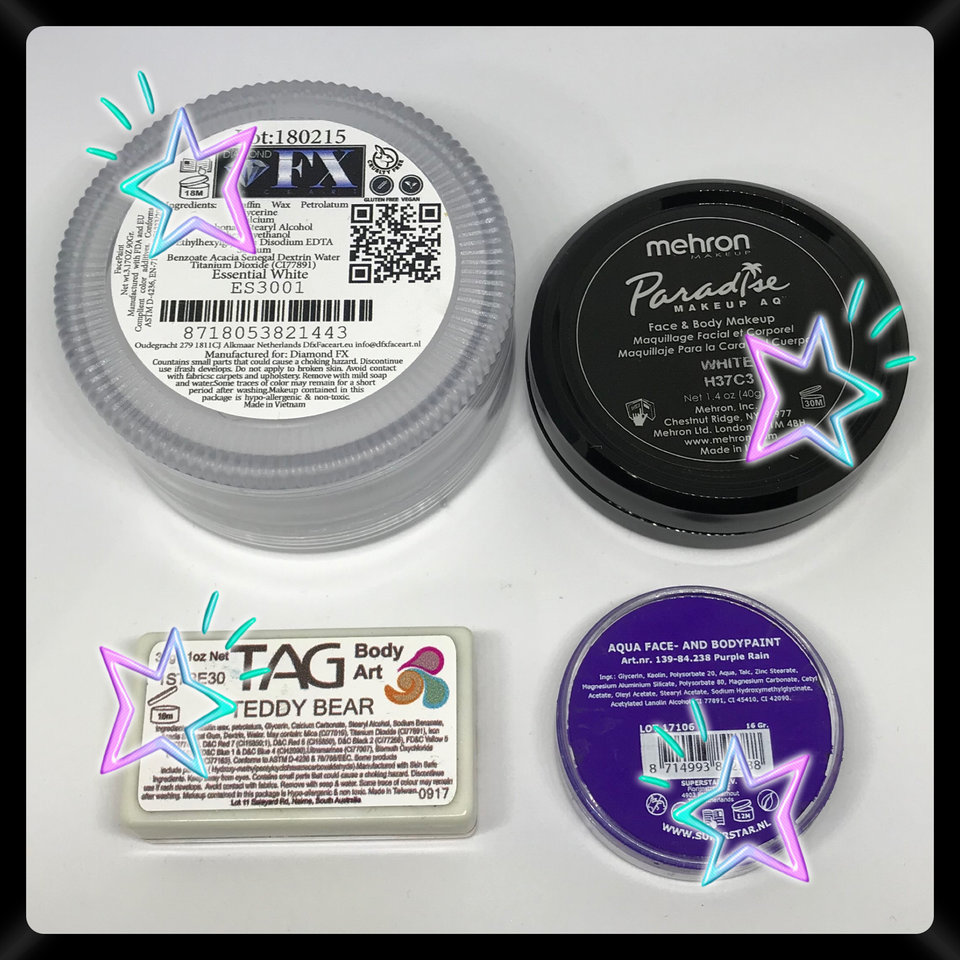
So, depending on how new you are to face painting, I’m sure most, if not all of you have heard of Snazaroo. I often hear parents in my line chatting to friends about the Snazaroo they have at home, so I know it’s a brand that hobbyists and beginners tend to try first. Most of us started out using it; probably because it was easily accessible years ago, most Fancy Dress Shops sold it and you could trust the brand was safe.
Basically, what I am saying is, if you have a selection of Snazaroo colours that you are wondering if you can use, then yes, you would be absolutely fine. They are FDA/EU approved, a perfectly good paint.
But, if you are looking at trying other brands and not sure which to start with, then what I will say is; I have found I like a lot of different paints, some more than others and some for specific uses. Paint is a bit like Marmite, what one person loves, another hates! So it’s not really a case of me saying “…… is THE best paint to start with”, because it’s just not that simple.
It’s exactly the same with brushes… a real personal preference. On one hand we are so lucky that we have such a huge variety to choose from, but on the other, it’s a bit of a minefield, especially when you start out and have never heard of some of these brands.
I remember finding a split cake by ‘TAG’ for the first time and I had no idea if it was good paint to buy, I felt like I needed someone to just say, “These are all excellent quality paints that many professionals use and would recommend”, to reassure me I wasn’t wasting my money. It was almost like a foreign language, I had no idea what things were! For example; if I said to you, my partner Mark owned a Giggle-Pin Winch for his Land Rover Defender, you probably wouldn’t know what I was talking about or whether that Winch was good or not!? That’s exactly how I felt when looking at face painting supplies. NB; Giggle-Pin are the best winches on the market! :-b But you only know, if you know!
In the beginning I didn’t know where to look or who to ask for this advice. Obviously now I know about things like; this Blog and all the great support groups on Facebook, including ‘The Face Painting Shop – Tips, Tricks and Questions Group’ where there is a world of knowledge and people willing to help out and offer suggestions.
https://www.facebook.com/groups/927565127253696/?ref=br_rs
Wait… What’s a JAM?!
OK, I’m sure this will get covered in more detail in future blogs, so briefly… a JAM is; a get together of Face and Body Painters. They give you a chance to meet like-minded people, watch some demos, play with your kits, have a cup of tea, eat some cake and sometimes buy painty goodies!
If you are looking to invest in any new paint when starting out, I would certainly recommend investing in a good Black and White. This is because black and white are going to be your most used paints, they are generally used to add detail and highlights to every design, so finding a good one will be of great benefit to you. You’ll find better coverage and crisper line work that will make your designs pop. I can’t tell you how much better my designs looked, once I found a black and white that provided that for me. Now before you jump in and click ‘add to cart’, I would suggest initially getting the smallest size available, usually 32g. That way, if you don’t get on with that particular brand, it won’t take too long to use up before you can try a different one. Top Tip: Once you have found a brand you like, I would definitely suggest buying the larger pots (45 or 90g) as they are the two colours you will use the most and it’s much better value for money.
My personal favourite Black and White Paint is DFX Essential, I know these are popular with a lot of face painters, although I’ve been hearing a lot of great stuff about Face Paints Australia White recently so I have just ordered myself one to try out. Top tip: It’s always good to have a backup paint in case your favourite one is out of stock!
I am not going to get into the differences in ingredients for all the brands today, as I assume you want to get to bed at a decent time… but it is worth pointing out that some brands are wax based and some are glycerine based. I am sure there will be a future blog about the differences of the ingredients and how they perform.
As for solid colour paints, there are so many and TBH I pretty much like them all! I personally use a lot of Superstar (FAB in USA); it doesn’t need as much water to activate as some other brands and you’ll find it quite soft in consistency to others. This is something I particularly like about it, but I know this is the reason that others don’t get on with it… so Tomatoe/Tomato! Just FYI, another of my favourites is Global colours.
Top Tip: I think the most important thing to look at when choosing your solid paints, is what shades you like. Every brand has slightly different shades, so choose the colours that you love.
ONE STOKES/ARTY CAKES/SPLIT CAKES/RAINBOW CAKES: If you are anything like me when I started, I was completely confused… what’s the difference between all these ‘cakes’?! So here you go…
One Strokes & Arty Cakes are basically the same thing. They are all in the smaller pots approx. 1inch wide in a variety of stripy colours for you to swipe your flat/angled brush across, to produce beautifully blended colours in ‘one stroke’.
Split Cakes & Rainbow Cakes are the larger pots that you can swipe a sponge across to produce the same blended colours over a larger area.
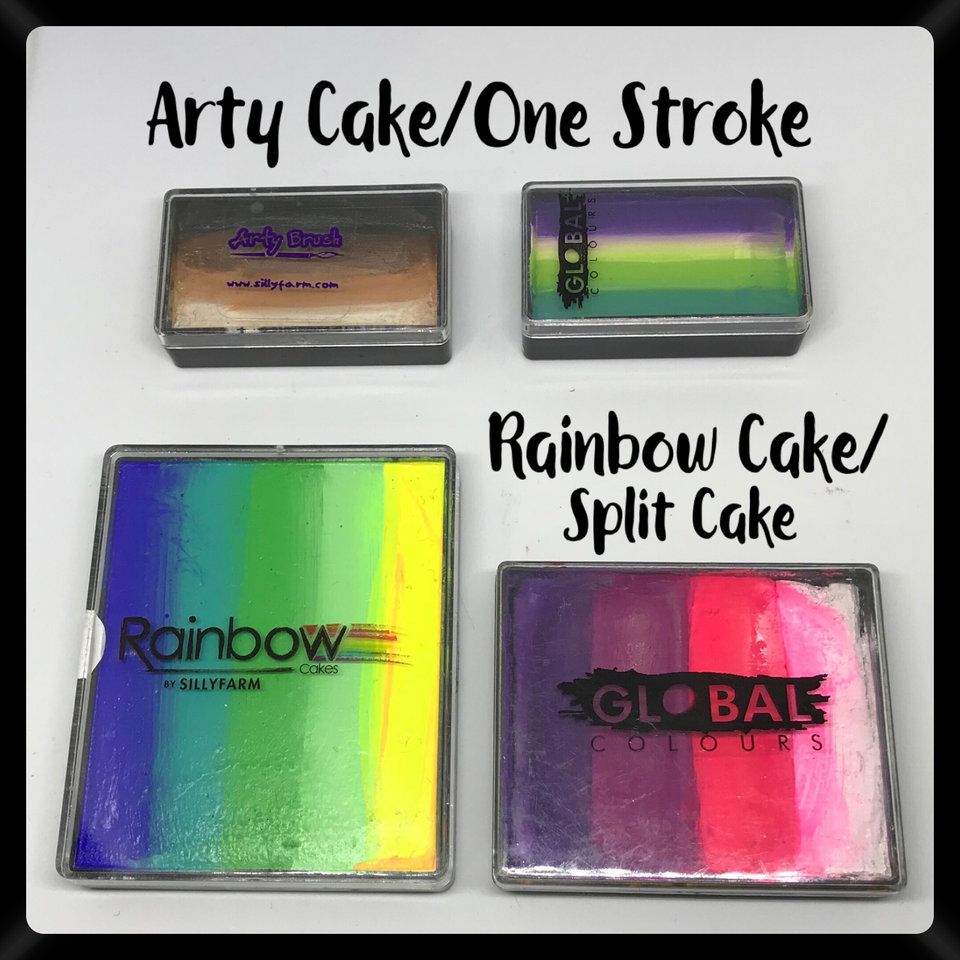
It’s exactly the same principle with these colourful little pots of joy, every brand is slightly different, you will no doubt have a preference as time goes on, but ultimately choose the colours you love and that will fit well with your designs.
So here it is… (In no particular order) the list of brands I think are pretty great and you can’t go far wrong with:
Diamond FX (DFX)
Global Colours
Superstar (FAB)
Face Paints Australia
TAG
Mehron
Kryolan
Party Xplosion
Cameleon
AND FINALLY…. BRUSHES!
I perhaps shouldn’t be trusted with giving advice on brushes, as I am a self-confessed Brush Addict! (Please don’t judge me!)
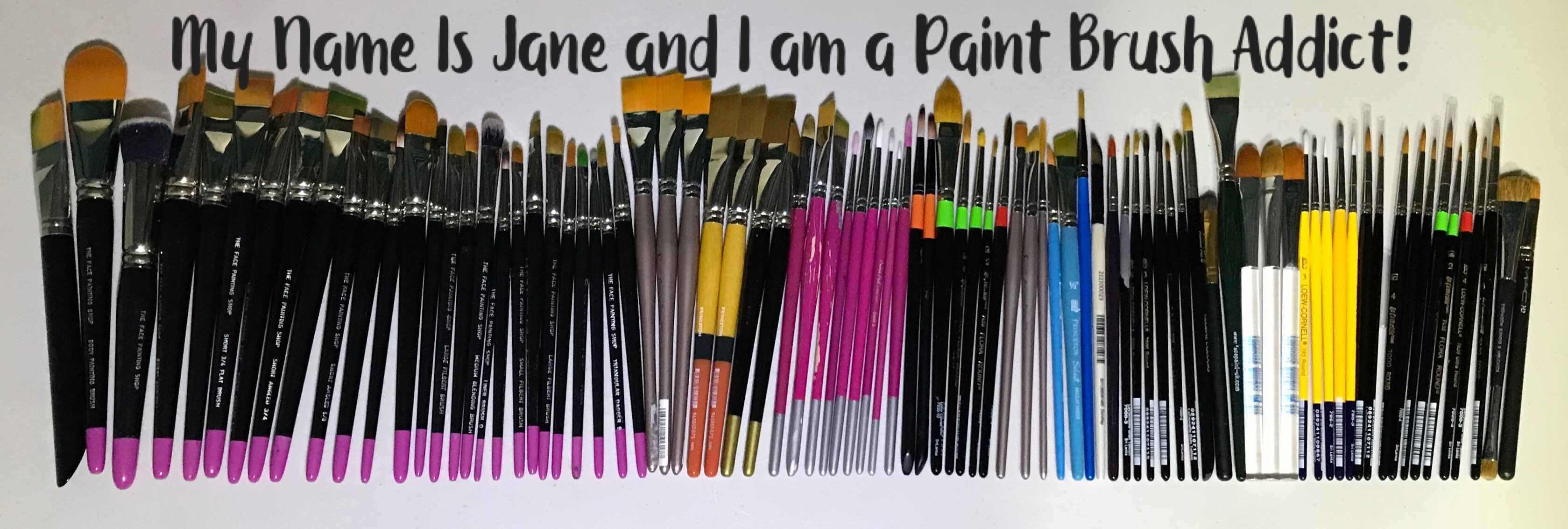
Firstly, don’t feel the pressure from seeing other people’s huge brush collections… *Who? Me?* you don’t need that many (That’s what I keep telling myself! Lol)
Personally I have built up my collection over time and in my defence, I have a selection that I use on every job, then I have speciality brushes for specific designs I paint, that make it easier and faster for me. I also have duplicates so I can have a dedicated brush for black and one for white etc. and then, I have a stock pile of my favourite brushes in case one should break or get lost or be discontinued or… you get my drift!
I also have a mixture of brands, none better than the other; I have just found through experience, there are brands of brushes I like for different techniques and that I produce better work with. It really is a case of trial and error. This can obviously be expensive, so I refer you back to my top tip about training and JAMS.
Are you still with me? Hold on in there, we are on the home stretch.
If you were wondering what specific type of brushes to buy when starting from scratch, here’s a good selection of what I think would set you up well to produce a wide variety of designs.
Liner Brush – Great for delicate swirls on eye designs or super fine whiskers
Round 2 or 3 – Great for line work (Top Tip: x2 so you have one for black and one for white)
Round 5 or 6 – Great for tear drops and thicker line work
Flora – Great for petals (if you can, get a couple in different sizes this will add interest to floral designs)
Filbert Brush – Great for filling in larger areas and for bigger tear drops or monster horns
Flat and/or Angled 1/2, 3/4, & 1inch – Great for one strokes/arty cakes. These are available in short or regular length bristles. Everyone has a preference, but I personally found as a beginner I had more control with the short bristles. I now use a mixture of normal and short. Again, initially I found I had more control with the angled brushes, but I now use flat and angled depending on what I am painting.
And last but not least, here is a list of brush brands that I absolutely love and would recommend trying:
The Face Painting Shop Pinktips (I am not just saying that because of my blog, they honestly make up the majority of my brush collection!) – I pretty much love all of them!
Loew Cornell – (These are my go to line work brushes)
Sillyfarm Paint Pal – (I Love their petal, drop brushes and Cameron Garrett range)
Mark Reid – Signature #4 & #6 are my go to tear drops and dots brushes
Princeton – I found these hard to find, but I have a couple of their angled brushes I absolutely love
Natalee Davies – My go to butterfly brushes
Da Vinci – Love the handle shape of these, lovely to hold and paint with
And that is it my friends! I do hope some of you found this helpful… let me know in the comments your thoughts and what paint or brushes you love. Not forgetting, if you have any questions on anything I have mentioned then please ask away.
Thanks so much for reading… feel free to give me a like or follow on my social media pages below to see what I’m up to, my recent work and updates.
Jane x
www.thefacepaintingshop.com
Facebook.com/daisyjanesfacepainting
Instagram.com/daisyjanesfacepainting
Get Your Halloween On…..
Get Your Halloween On…..
Whether you love it, or hate it, the Spooktacular season is on its way! I thought I’d write my second blog about my top tips for getting through those few crazy weeks unscathed. Halloween is probably our busiest time of the year, and the earning potential in these few short weeks is huge!! To maximise this there are lots of things you can do….
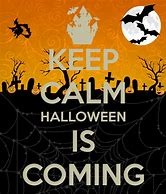
Boost your Bookings
If you are still becoming established, or want to ensure that your diary is nice and full over the Halloween period, now is time to start drumming up that business! Make sure you’ve got some fabulous spooky designs that you can use as examples (and have permission to use them) – if not, now’s the time to start turning friends and family members into skeletons, zombies, witches, etc – and it’s time to get your art out there! Use social media to advertise your business on local community groups and ask for people to share and share again. Contact play centres and local businesses and try and think outside the box - lots of companies get involved in Halloween now -hairdressers, nail bars, any public-facing businesses. Approach these with your knock-out spooky designs and a professional email and see what they say!
Managing your bookings
When the bookings start flooding in, whether you base yourself at home, or are mobile - it’s essential that you manage your time well. Better to do the legwork now, than in the midst of all the craziness!! So:
- Know how long each design takes you, and allow an extra 10-20 minutes for a quick intro, any time you run over and taking payment at the end.
- Get a deposit- or booking fee, no booking fee= no appointment! I always take 50%.
- Ask for photos of the type design they would like. This is REALLY important. In this day of computer generated images, filters and airbrushing we may need to aherm ‘manage’ a clients expectations. ‘No I’m afraid I can’t make you look like an airbrushed picture of Taylor Swift, but yes I can do a ‘corpse bride’ design with a two special fx wounds..’
- Send a contract with every booking, and in that contract stipulate that if that client is late then they may not get painted – remind them politely to be on time in the email too!
Pricing
My main piece of advice on pricing is DON’T SELL YOURSELF SHORT. You are a skilled professional, who can create amazing looks for your clients. Decide on your prices and stick to them - believe that you are worth every penny of what you are charging (I know, this isn’t always easy, but it’s something I’ve learnt to do). I never negotiate with people that try and haggle with me over prices – I just honestly tell them that I understand if they go for a cheaper option but that we are worth every penny. Don’t forget to take your travel time and costs into consideration, and as per usual parking etc.
Networking
If you haven’t already, now is a great time to reach out to your local network of Professional Face Painters, either through social media or just by picking up your phone and calling them! My links to the other face painters in my area have proved absolutely invaluable, we are able to share jobs around, reach out when we need cover, and at busy times of the year -like Halloween-get together and support each other when only another face painter knows how you feel!!
So, that’s it for this week – I hope you can use some of this practical info to help you on your way to prepare for the Halloween season. Next week’s blog is going to cover some of my go-to essential products for Halloween, and will include a step-by-step using some of the gorgeous products in my bloggers box from the fabulous Face Painting Shop.
See you then!
Kate xxx
When It All Goes Wrong
When It All Goes Wrong
It will happen to you and if it hasn’t yet, its just a matter of time. The messed-up design, the forgotten party, the upset parent. Mostly things run smoothly but sometimes things do go wrong and, believe it or not, it’s okay, the child will be happy, the host can be recompensed, the parent placated. We learn from our mistakes and should actually be grateful for them because they make us better business people and facepainters. Read on..
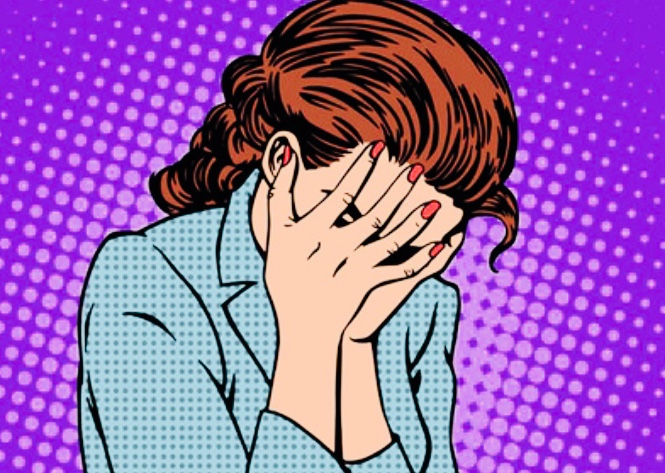
Scenario 1 – the messed-up design.
We’ve all been there haven’t we? Got a bit over-excited and bitten off more than we can chew at a busy party. ‘Darth Vader, yeah no problem, take a seat!’ Ten minutes later you’re sweating and wondering how you got here, this isn’t how its supposed to look, you start to panic a bit as you become very aware of the parents standing behind you, their arms folded, smiling and watching expectantly. The kid looks like he’s wearing a charcoal mud pack, his face is totally black except for two alarmed eyes and he can’t speak because three layers of paint have tightened his face so much he can’t move his lips. You can’t wipe this off, it’s gone too far for that, and you can’t chuck glitter on because Star Wars don’t do disco. Here’s what to do – get that child out your chair as quickly as possible, act amazed at how wonderful they look, smile, smile, smile and give them the briefest glance in the mirror then send them on their way. Nine times out of ten the kid will like it and the parent will take a photo.
Now what can we learn from this toe-curling experience? DON’T GET YOURSELF IN THIS SITUATION IN THE FIRST PLACE! A busy party is not the place to try out new designs unless we are pretty sure we can pull it off. If the parent is insistent then you can use the Time and Stain responses. ‘I’d love to do Darth Vader but it takes a lot of time and I wouldn’t want you to miss the fun.’ If that doesn’t work I guarantee success with this one ‘Darth Vader? Hmmmmm that uses a LOT of black and (looking at parent) I’m not going to lie, it’ll take a while to wash off’
N.B If your messed-up design is on anything other than a Star Wars character chuck some glitter on top. Seriously. The chunkier the better.
Scenario 2 – The forgotten booking.
This is one of the worst feelings – you’re at home with the kids or maybe in the pub and your phone flashes a message ‘Are you still coming? We’re waiting for you..’ and your stomach clenches as you realise you’ve forgotten all about the wedding/party/hen do and there’s no way you can make it. So, what do you do? Contact the organisers straight away. Call, text, dm, whatever, just let them know you’ve made an error and apologise, even if it was their mistake. They may be upset, they may not, I was certain the bride would be fuming that I had forgotten to turn up for her big day but she was fine, ‘Everyone was having such a good time’, she said, ‘we didn’t even realise you weren’t there.’ Parents are more likely to be upset when it’s their child who is let down, so for the forgotten birthday party try and make it, even for the last half hour, and if that’s impossible offer a reduced price for a future booking as way of apology.
Lesson we can learn: once a week go through all your enquiries and bookings and cross reference, bookings can slip through the net, especially at busy times in our lives. Always admit your mistake, people just like to feel listened to.
Scenario 3 – The upset parent or care-giver
This all depends on the reason for the upset. If there’s a legitimate reason then stay calm and listen as it helps diffuse any anger. If the upset is unreasonable like a demand for a face paint when the line is closed (hands up who this HASN’T happened to) then stand your ground. Always stay calm. If the parent has been drinking it’s even worse and you are totally within your right to completely ignore them, close your kit and walk away.
Lesson learned? Listen, stay professional, accept blame if it is justified. Rudeness is never ok, either from you or towards you.
Do you have any top tips for when it all goes wrong? What do you do in tricky situations? Leave your comments below, I’d love to hear what you have to say.
(Next week: The 2 minute rainbow unicorn)
Joni Nettleship
Face Painting by Joni
It will happen to you and if it hasn’t yet, its just a matter of time. The messed-up design, the forgotten party, the upset parent. Mostly things run smoothly but sometimes things do go wrong and, believe it or not, it’s okay, the child will be happy, the host can be recompensed, the parent placated. We learn from our mistakes and should actually be grateful for them because they make us better business people and facepainters. Read on..

Scenario 1 – the messed-up design.
We’ve all been there haven’t we? Got a bit over-excited and bitten off more than we can chew at a busy party. ‘Darth Vader, yeah no problem, take a seat!’ Ten minutes later you’re sweating and wondering how you got here, this isn’t how its supposed to look, you start to panic a bit as you become very aware of the parents standing behind you, their arms folded, smiling and watching expectantly. The kid looks like he’s wearing a charcoal mud pack, his face is totally black except for two alarmed eyes and he can’t speak because three layers of paint have tightened his face so much he can’t move his lips. You can’t wipe this off, it’s gone too far for that, and you can’t chuck glitter on because Star Wars don’t do disco. Here’s what to do – get that child out your chair as quickly as possible, act amazed at how wonderful they look, smile, smile, smile and give them the briefest glance in the mirror then send them on their way. Nine times out of ten the kid will like it and the parent will take a photo.
Now what can we learn from this toe-curling experience? DON’T GET YOURSELF IN THIS SITUATION IN THE FIRST PLACE! A busy party is not the place to try out new designs unless we are pretty sure we can pull it off. If the parent is insistent then you can use the Time and Stain responses. ‘I’d love to do Darth Vader but it takes a lot of time and I wouldn’t want you to miss the fun.’ If that doesn’t work I guarantee success with this one ‘Darth Vader? Hmmmmm that uses a LOT of black and (looking at parent) I’m not going to lie, it’ll take a while to wash off’
N.B If your messed-up design is on anything other than a Star Wars character chuck some glitter on top. Seriously. The chunkier the better.
Scenario 2 – The forgotten booking.
This is one of the worst feelings – you’re at home with the kids or maybe in the pub and your phone flashes a message ‘Are you still coming? We’re waiting for you..’ and your stomach clenches as you realise you’ve forgotten all about the wedding/party/hen do and there’s no way you can make it. So, what do you do? Contact the organisers straight away. Call, text, dm, whatever, just let them know you’ve made an error and apologise, even if it was their mistake. They may be upset, they may not, I was certain the bride would be fuming that I had forgotten to turn up for her big day but she was fine, ‘Everyone was having such a good time’, she said, ‘we didn’t even realise you weren’t there.’ Parents are more likely to be upset when it’s their child who is let down, so for the forgotten birthday party try and make it, even for the last half hour, and if that’s impossible offer a reduced price for a future booking as way of apology.
Lesson we can learn: once a week go through all your enquiries and bookings and cross reference, bookings can slip through the net, especially at busy times in our lives. Always admit your mistake, people just like to feel listened to.
Scenario 3 – The upset parent or care-giver
This all depends on the reason for the upset. If there’s a legitimate reason then stay calm and listen as it helps diffuse any anger. If the upset is unreasonable like a demand for a face paint when the line is closed (hands up who this HASN’T happened to) then stand your ground. Always stay calm. If the parent has been drinking it’s even worse and you are totally within your right to completely ignore them, close your kit and walk away.
Lesson learned? Listen, stay professional, accept blame if it is justified. Rudeness is never ok, either from you or towards you.
Do you have any top tips for when it all goes wrong? What do you do in tricky situations? Leave your comments below, I’d love to hear what you have to say.
(Next week: The 2 minute rainbow unicorn)
Joni Nettleship
Face Painting by Joni
Face Paint Swatches
My Kit, Solid Colours... Kathryn Craig
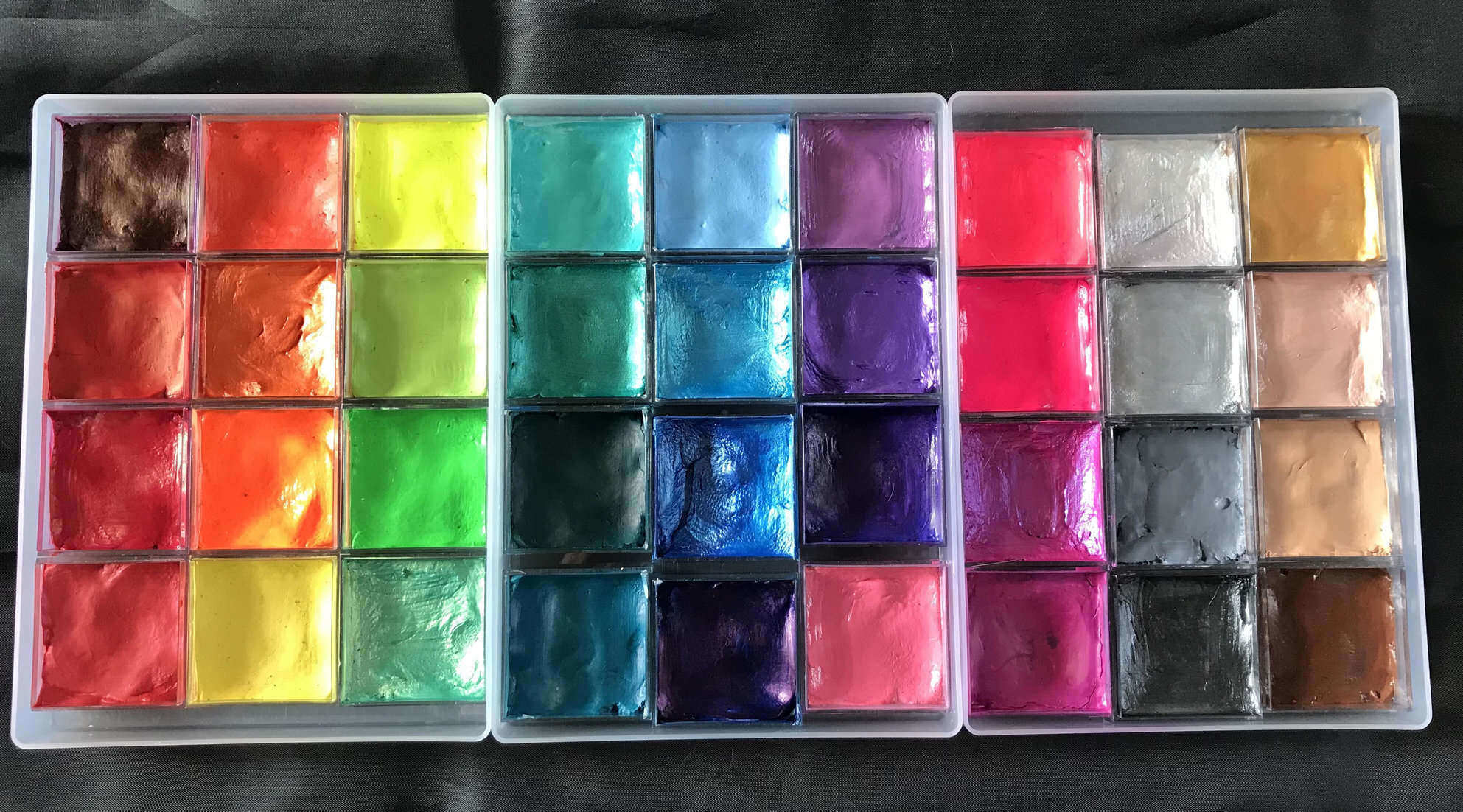
Like my one strokes, I don’t restrict myself to any one brand, as I find that certain brands are better for certain colours or jobs. Superstar shimmers are amazing, so almost all of my metallic paints are by them. Global make beautiful dark colours, which are rich, solid and firm so they are great for line work. Tag, DFX and Cameleon are good all-rounders so there are some of those thrown in for good measure too!
So… repotting. I know that this is a contentious issue and there is a lot of chat about whether it is safe / responsible / hygienic / insurance compliant, but it works for me, and my insurer doesn’t have an issue with how I do it. I like how my set up & breakdown times are much faster because I don’t have 36 individual lids to fiddle with. Each A5 document box holds 12 Amac boxes (perfectly!) and I store them without the individual lids on, so I only have 3 lids to manage. Being square, and smaller in size than the standard round 32g pots, the Amac boxes mean that I can also carry more colours. (The same space fits around 18 x 32g pots!) I think it looks better when set up, and I like the flexibility that it gives me to change things around for different jobs, for example for nightclub jobs I will often just bring one set of 12 paints, with my neons and a few metallic inside, meaning that I can travel light & make a quick getaway when the event ends! I will say that I do my repotting very carefully. My kitchen is scrubbed clean before I start, I wear latex gloves, and I mark the bottom of each Amac box with details of the brand, colour, date of opening & batch number. I also retain the original container so that, in the unlikely event of there being a reaction or anything else that means that I need to trace the paint origins, I can easily do so. I never add new paint to the old so that there is only ever paint from a single batch and pot in each container, and I can always be sure of the expiry date. For everyday use, I tend to keep the paints in the same order because muscle memory is real, and those seconds really do count at busy events!
TRAY 1
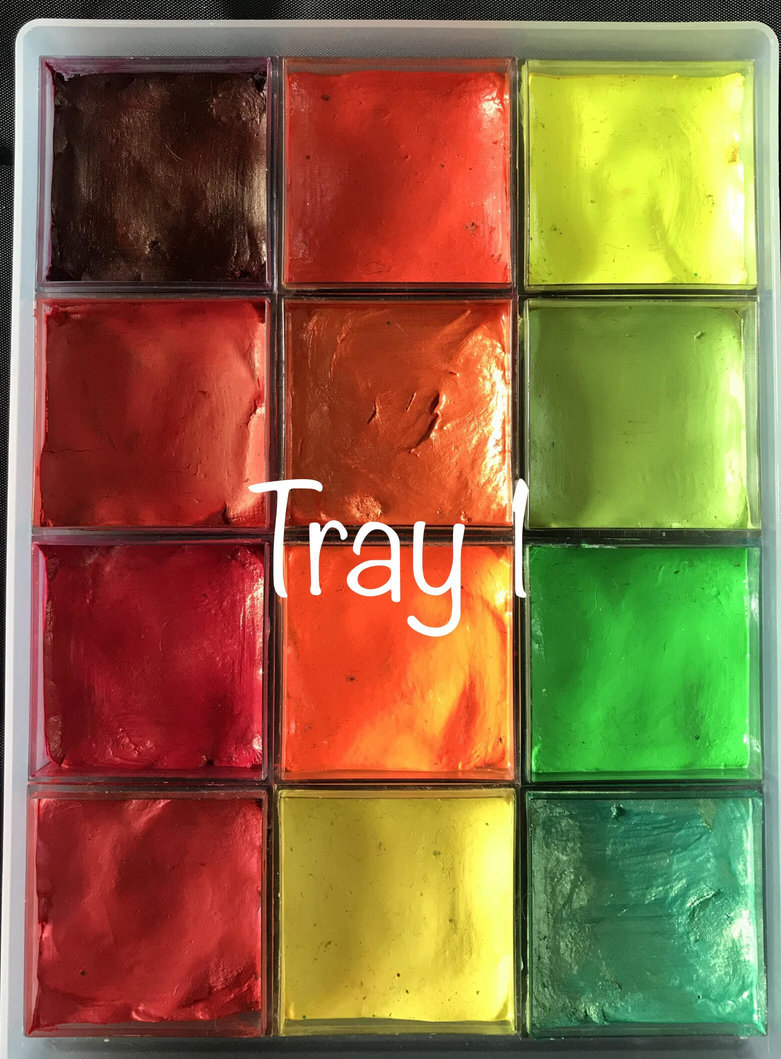
Superstar 127 – Old Red. I LOVE this colour. It is great for outlining butterflies, it makes beautiful double dip flowers, and it is awesome for SFX type work like grazes and dried blood. Any colour that works for princesses and zombies alike is a winner for me!
Global- Red. My go to red almost every time. It is so bright, coverage is amazing and it doesn’t even nearly stain! Great for classic Spiderman faces, reindeer noses and everything in between. It has the typical global firm consistency and is easy to load and use.
Superstar 040 – Pinky Red. This is a fairly recent addition for me and I’m loving it! As the name suggests, it is a pink toned red, and it is perfect for more girlie Spiderman designs, and I’m pretty sure it is the EXACT colour of Ariel’s hair!
Global – Pearl Red. Needs no real introduction other than being that perfect global red, in pearl form!
Second Column, Top to Bottom-
Superstar 033 – Bright Orange. This is the best tiger orange ever. As I find with some Superstar paints, it’s not the crispest paint for line work that ever existed, but it sponge blends like a dream!
Superstar 236 – Ploppy Orange. A close second for amazing tigers. Superstar produce amazing metallic colours and this is no exception. I usually use this for tigers on little kids, along with gold, as it gives a softer result but still shouts RAWWWRRR! This applies perfectly with a brush or sponge so is super versatile.
TAG – Neon Orange. I only carry 5 solid neons and this is always one of them. I find Tag neons to be the best that I’ve tried, and the most consistent in terms of UV and non UV use. I use it for outlining sometimes to make designs pop, and it’s great for adding some depth to designs with larger red or regular orange areas.
Global Yellow. Hands up who finds it hard to find a solid yellow paint with really good coverage? Thankfully, I don’t get asked for too many Minion faces these days, (I’m really not a fan of those little things- whatever they are!) and not much else calls for a solid yellow, so I’ve kind of given up the search. I was using Superstar yellow for sponge work and Cameleon Banana for line work, but decided that I really didn’t need to carry 2 yellows, so have settled on Global regular yellow as a decent compromise for both uses. It’s good, but you will still need 2 coats for any larger areas or on darker skin tones.
Third Column, Top to Bottom-
TAG – Neon Yellow. Like most neon yellows, it’s not great without UV light, but boy does it shine in the right conditions!
Global- Lime Green. I use this loads on everything from dinosaurs to foliage and it’s a great colour for brush work and sponging – blending beautifully!
TAG – Neon Green. Like the other neons, I rarely use this for anything other than UV work, but it’s also nice to add some definition on top of other greens for faces like Hulk, Dinos, dragons and Halloween witches!
Superstar 129 – Green Shimmer. I only added this to my kit last month having worked alongside another painter who had it, and it’s gorgeous! It’s a love subtle golden green with that typical Superstar pearlescent shimmer.
TRAY 2
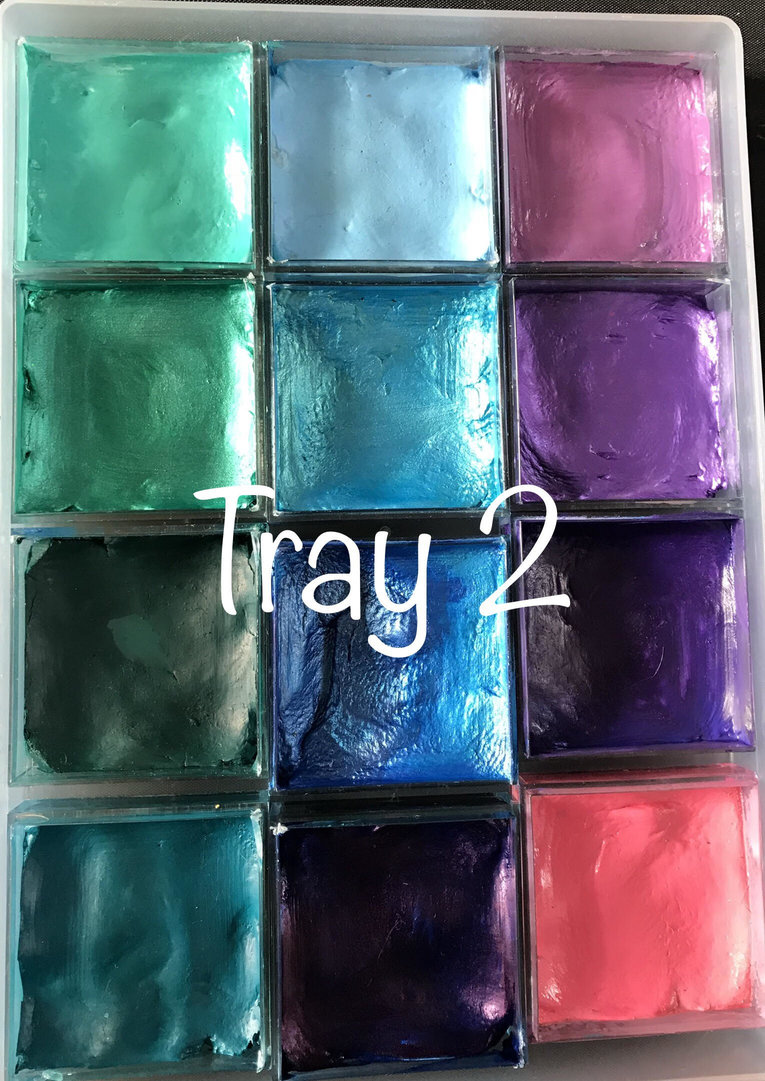
First Column, Top to Bottom-
TAG- Teal. I love this colour. I use it for foliage and outlines, unicorn hair and contrasting spots on butterfly wings. It also gives amazing triple dip petals with white and dark purple!
Superstar 341 – Peacock Shimmer. Another classic shimmer from Superstar, loads like a dream on a brush or sponge, and has a lovely consistency for line work. This colour works great with pearl red and gold for Christmassy designs too!
Global - Deep green. This is my go to green for foliage & swirls on floral designs, and for texture stencilling on monsters, dragons and dinosaurs. Global’s range of dark colours are all stunning and this is no exception.
Superstar 173 – Petrol. I actually won this colour in a TFPS giveaway, and I’m glad that I did as I don’t think I would have tried it otherwise. It is a beautifully rich blue-green, and is amazing for line work, and outlining green designs. I love it!
Second Column, Top to Bottom-
Global- Light blue. Honestly, I rarely seem to use light blue but this is in there just in case!
Superstar 220 - Ziva. Are you even a face painter if you don’t love Ziva? This has to be the ultimate colour. It pops like nothing else, sponges and brushes on amazingly and brings the ‘WOW factor’ to any design I can think of! If you don’t have this, you need it! The only drawback that I’ve found is that it does transfer, so it’s maybe not ideal for larger areas of paint on sweaty children, but other than that it is truly an amazing paint.
DFX - Metallic Blue. This is another amazing colour, and was made for Captain America designs. It has great coverage and loads perfectly. It makes a great highlighter for blue roses too!
Global - Dark Blue. I can’t imagine my kit without Global dark blue in it. It’s a really deep inky blue with an almost metallic sheen. I use this to outline blue and green designs in place of black. It is super pigmented so I don’t use it for large areas of paint (after one particularly traumatic incident with a small child, a bouncy castle, and some white jeans…) but it is still a must have colour in my opinion!
Third Column, Top to Bottom,
Superstar 039 – Mauve. I’m surprised that I don’t reach for this more often as it’s a great colour. As per the name, it is a pinky purple colour, and is great for line work. I only seem to use this regularly for butterfly antennae, but I’ve set myself a little challenge to use it more this week… I shall let you know how that goes!
Superstar 238 – Purple Rain. Another perfect shimmer from Superstar. Purple is my favourite colour, and this is my favourite purple. It’s great for line work and sponging, and is a really rich colour with a great metallic sheen.
Global - Purple. This is a lovely deep purple and it’s great for outlining. I don’t use it a lot for sponging as it is pretty dark, but I wouldn’t be without it in my kit!
TAG – Regular Pink. This is the only solid pink that I carry in my kit, and it’s a good all-rounder. I use it for rosy cheeks, flowers, and everything else that requires a baby pink colour!
TRAY 3
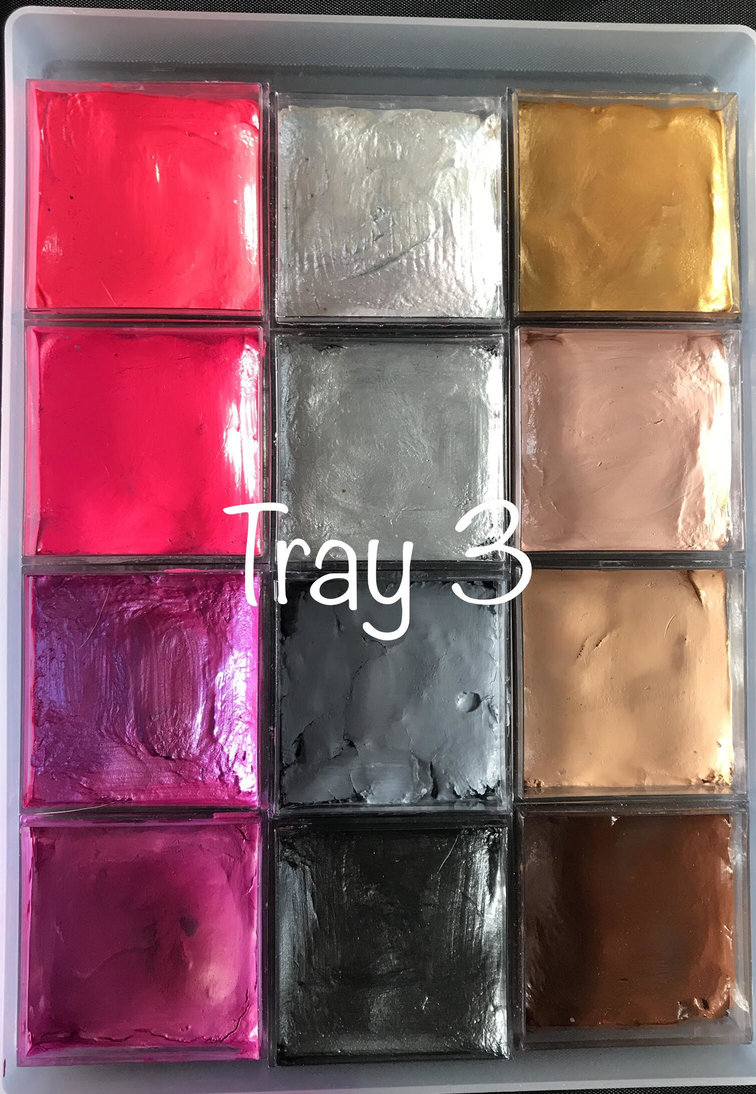
First Column, Top to Bottom-
TAG- Neon Pink. This is one of the Neons that I use for line work as well as UV work. This and Neon magenta (below) are the 2 neons that I use most…usually for unicorn hair and outlining. They can be a little ‘waxy’ so need quite a lot of working before they are ready to use for non UV work, but providing you do that, they both give a nice solid neon pink colour. As the name suggests, the magenta is a little darker and richer than the pink.
TAG Neon Magenta. As above!
Superstar 139 – Pink Shimmer. I LOVE THIS! It is a great colour. Like most Superstar shimmers it is pretty soft and needs little water to work it, but once you get the hang of it, it’s super versatile. It has a gorgeous pinky purpley shimmer and it’s my go to for lip colour also!
Global- Magenta. Another staple, and another fabulous deep rich colour from Global. I go through a lot of this, and use it for every kid of design, but it makes beautiful double / triple dip petals!
Second Column, Top to Bottom-
Superstar 140 – silver shimmer. Finding a white / silver shimmer that works for lines and bases is tricky. They seem to be great at one or the other but not both – but this is the best that I’ve tried. It’s super sparkly and blends like a dream, and is great for all those upcoming Halloween sugar skulls!
DFX Silver. Silver isn’t a colour that I use a lot, but this is in there just incase I happen to need one! Does what it says on the tin, and is a deeper grey-silver than the superstar above.
Cameleon – Fifty. I don’t use a lot of grey, and I’m honestly not use that I’ve tried any others, but Fifty is a great shade, and, like most Cameleon paints, is great for both blending and line work.
Superstar 233 – Graphite. WHAT A COLOUR! This is a recent addition for me and I’ve been using it a lot in place of black for a softer look. I’m planning to use it a lot at Halloween as it is a great, super shimmery true graphite colour and much more rich and eye catching than regular black. It’s a typical superstar soft metallic and is a really stunning addition to any kit!
Third Column, Top to Bottom-
Cameleon- Oscar. I’ve tried lots of golds but this is my favourite. It’s a rich, bright yellow gold which shimmers but doesn’t sparkle, making it ideal for iron man! It applies really smoothly and, provided you take your time loading it, doesn’t need a second coat like most golds seem to!
Superstar 015 – Skin. Again, I don’t use this a lot but keep it incase I need it! (Does this make me a paint hoarder?) It is a great medium skin tone colour with a pink undertone.
Tag - Regular Bisque. This is the middle colour from the Tag Teddy Bear one stroke, and is great for animals and darker skin tones. Like the Superstar above, I don’t need it a lot but I keep (hoard?) it just incase!
Superstar 024 – Chocolate Brown. My go to brown! Rich, creamy and easy to blend, it is great for outlining designs using the Tag Teddy Bear one stroke, and for animal designs in general!
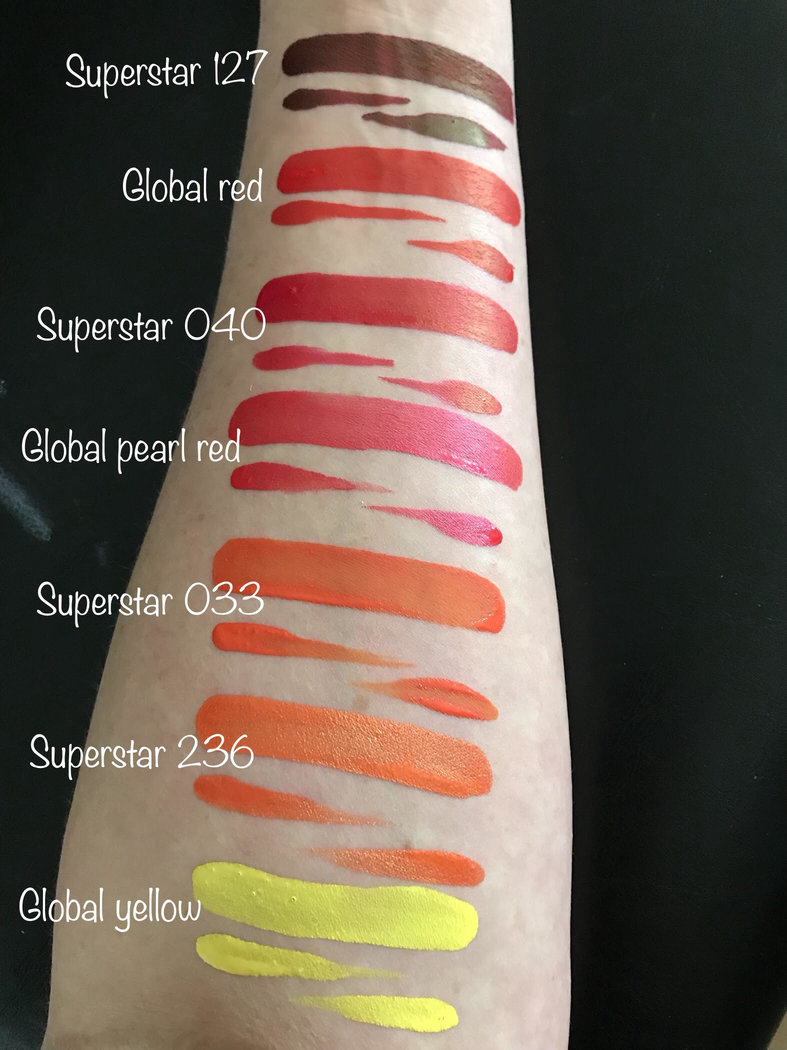
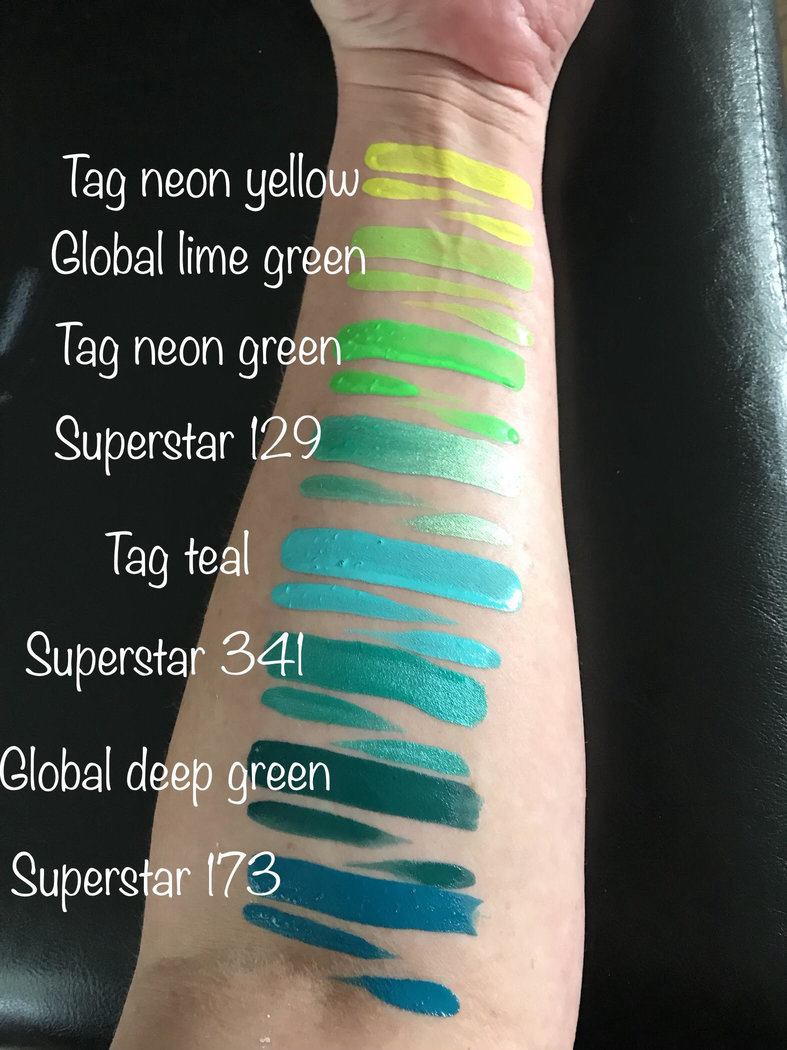
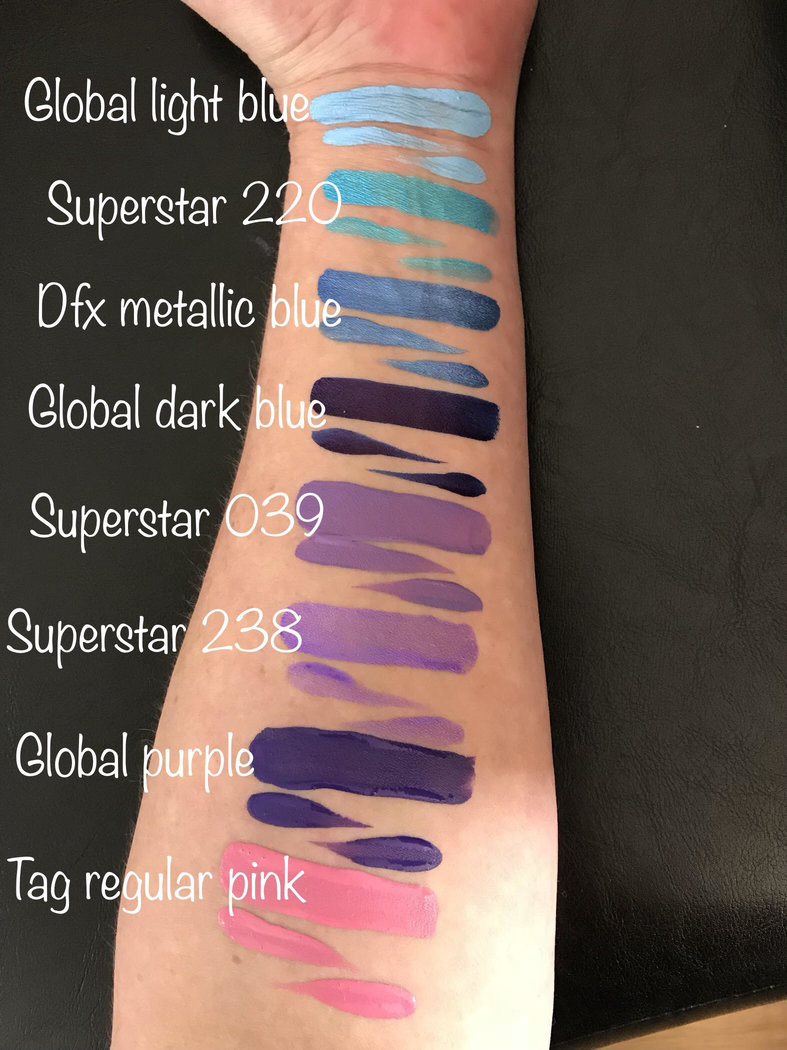
.jpg)
This brings me to the end of my ‘Introducing my kit’ series of blog posts. I hope that they have been helpful - make sure you bookmark them for future reference!
Next week I will be demoing a fast zombie design which is great for busy Halloween events and doesn’t require any SFX materials so fab for beginners and pro’s alike!
Kathryn!
A Beginners Guide to Body Painting
A Beginners Guide to Body Painting
What Paints Should I use?
Everyone has their own personal preferences with regards to body paints, the same way you do with face painting, and most people will start with brush and sponge. For body painting I find softer paints give a much more even coverage and blend into each other better than harder paints. I love Superstar and Mehron for covering big areas but I will still go back to Global and DFX for linework and detail aspects, but if I’m honest, my choices are largely based on the colours I want to use. You’re also going to want to think about getting some bigger brushes if you don’t already have any, as well as some blending brushes.
But I can’t draw?!
Does that stop you face painting? No! I had no artistic background before I trained as a hair and makeup artist, which is where I started face and body painting. I’ve found that actually my drawing has improved hugely since I’ve been body painting, and I understand so much more about shade and light, we all have to start somewhere! Some of my favourite pieces have been really really simple and really fun to paint, and require zero drawing skills. The picture below was one of my first body paints. It was the photographers idea, and all we did was take Mehron metallic silver powder, mix it with baby oil and cover our model. We got some photo’s at this stage before literally throwing handfuls of Holi paint powder at her. Because we had mixed the Mehron powder with oil and not mixing liquid (because it would give a shinier result), the powder paint was constantly moving, and no two photo’s are the same, which was awesome! We then also dribbled some of the silver paint back over the powder paint to break up the solid blocks of colour. It was unbelievably simple, but so much fun and still one of my favourite pieces.
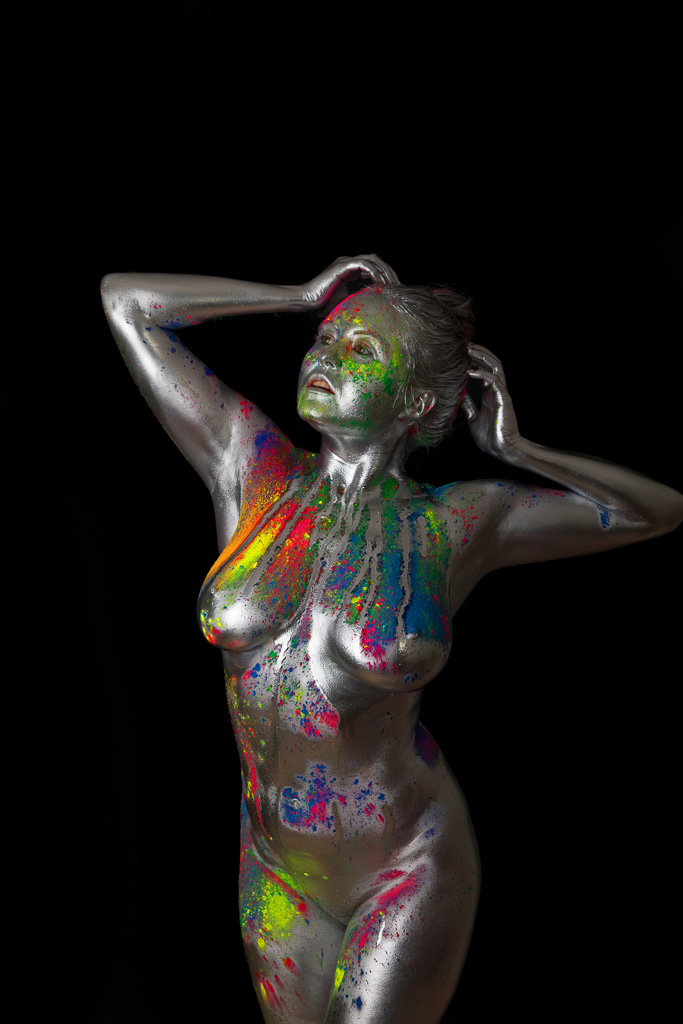
Where do I start?
If you want to start body painting but you’re not sure about ideas, pick a Halloween character and paint them! Halloween month is now in full swing, and we’re all busy promoting ourselves for the big day, so pick something that you can use to promote yourself for Halloween! The Joker is a classic and will not only be a great start to your body painting portfolio, but will be a great addition to your face painting portfolio. It can be really hard to come up with ideas when you don’t have a theme to paint to (I hate that feeling when I get someone in my chair and says ‘paint anything!’), so I am going to set you a challenge, yes YOU! If you have been thinking about starting body painting but you have been too nervous, I want you to find a willing friend or family member and paint them as the Joker. You can stick to the top half of the body if you want but I want to see what you get up to, tag me on Instagram or Facebook or wherever you post it! Like so many other things, once you start, you’ll wonder what you were so worried about.
Composition
This is why I think the Joker is a good place to start. It’s really important to think about the composition of the body and how it will affect design choices in your body painting, and painting clothing can be a really helpful exercise, not only in composition, but also for thinking about shadows and highlights, and making something look more 3D.
Also think about the muscle structure and the natural shapes and contours of the human body. It’s a really good exercise in understanding composition, will help in designing other pieces, and can be really useful if you decide to paint cosplay designs or zombies etc. Another really good exercise for composition, especially if you want to paint something more illustrative, is to look at heraldry and tattoo designs. Pick a theme and think about image placement, what aspects are more important, how can you fill dead space?
For me, body painting works best when you look at why are you choosing to paint on a body and not a canvas. How will your painting be affected when the body moves, and how can you use this to your advantage?
What if I make a Mistake?
Don’t be afraid of making mistakes, that’s what baby wipes/re-usable eco cloths (would HIGHLY recommend, they are phenomenal!) are for! I also think it’s really important to acknowledge mistakes, to think about why something didn’t work and how you could do it differently next time, whether it’s a particular colour combination, a different brush or something you just didn’t like.
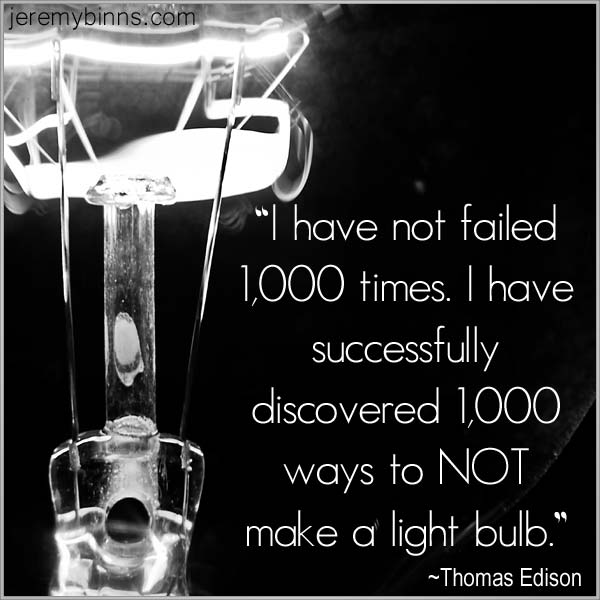
Where are the other painters at?
There are quite a few body painting groups and events that go on throughout the year, a lot of people also do their first body paints at these events too. We have all done our first body paint at some point, we have all been in that position where we don’t know anyone, we’re worried no-one will like what we paint and we’re scared that everything’s going to go wrong. So far I have found everyone I have met to be really encouraging and supportive, you’ve got nothing to worry about! Go to the the events, the festivals and the competitions, there’s always someone else in your position, and someone who will know about other events so you can do more painting!
What do I bring to my first body paint event?
A lot of the times, models bring their own underwear and nipple covers. I always bring spares in a variety of sizes and colours just in case. You’ll also want glue (pros-aide) and remover to stick those pesky nipple covers down and to remove them at the end, and cotton buds to apply the glue. In terms of what underwear to buy, I like Primark Seamless thongs. They’re quite easy to paint over and don’t suck up as much paint as cotton. Monster Pasties are by far the best nipple covers I’ve come across, but they are quite expensive. No Nips are also great, and they also make a line of ‘No Toe’ foam latex crotch covers which are a great alternative to thongs if you’re model is happy to wear them as there is no disruption to the paint. Everyone has personal preferences with underwear and nipple covers, it’s a case of finding what you get on with best.
It’s also a good idea to bring food and water. It can be a long day painting and, it hasn’t happen to me yet, but my worst fear is a model fainting, so make sure you keep checking in with them to make sure they’re ok and that they’ve had enough food and water. Also try to remember to let them sit down while you’re painting so they aren’t standing still for long periods of time. Temperature is also really important. Sometimes the venue where you are painting has no heating, or they’ll put you right next to a door so it’s a good idea to buy a portable heater. They’re pretty cheap and not too big so you can fit them into a suitcase with the rest of your kit.
Also you’ll need some form of floor and table cover. Believe it or not, not everyone enjoys colour and glitter explosions (although for the life of my I can’ think why!)
Ok I think I’m ready, What now?
Just do it! Get those paints out and find a victim ….*ahem* willing model, and show me how you get on! I wanna see!
I hope you have found this useful. If you have any questions or want some information about upcoming body paint events please ask me, I don’t bite! Also please let me know if you have a topic you would like me to cover in any upcoming posts.
Happy painting!
Mazz
https://www.instagram.com/mazz_loxton/
Subscribe to:
Posts (Atom)







